Human Resource Management Principles
VerifiedAdded on 2020/02/05
|20
|6007
|150
Essay
AI Summary
This solved assignment delves into fundamental Human Resource Management (HRM) principles. It explores topics such as HR planning, using illustrations to demonstrate its process. The influence of motivational theories, including Maslow's Hierarchy of Needs and Herzberg's Two-Factor Theory, is analyzed. Furthermore, the crucial role of HRM in strategic management and organizational success is discussed.
Contribute Materials
Your contribution can guide someone’s learning journey. Share your
documents today.
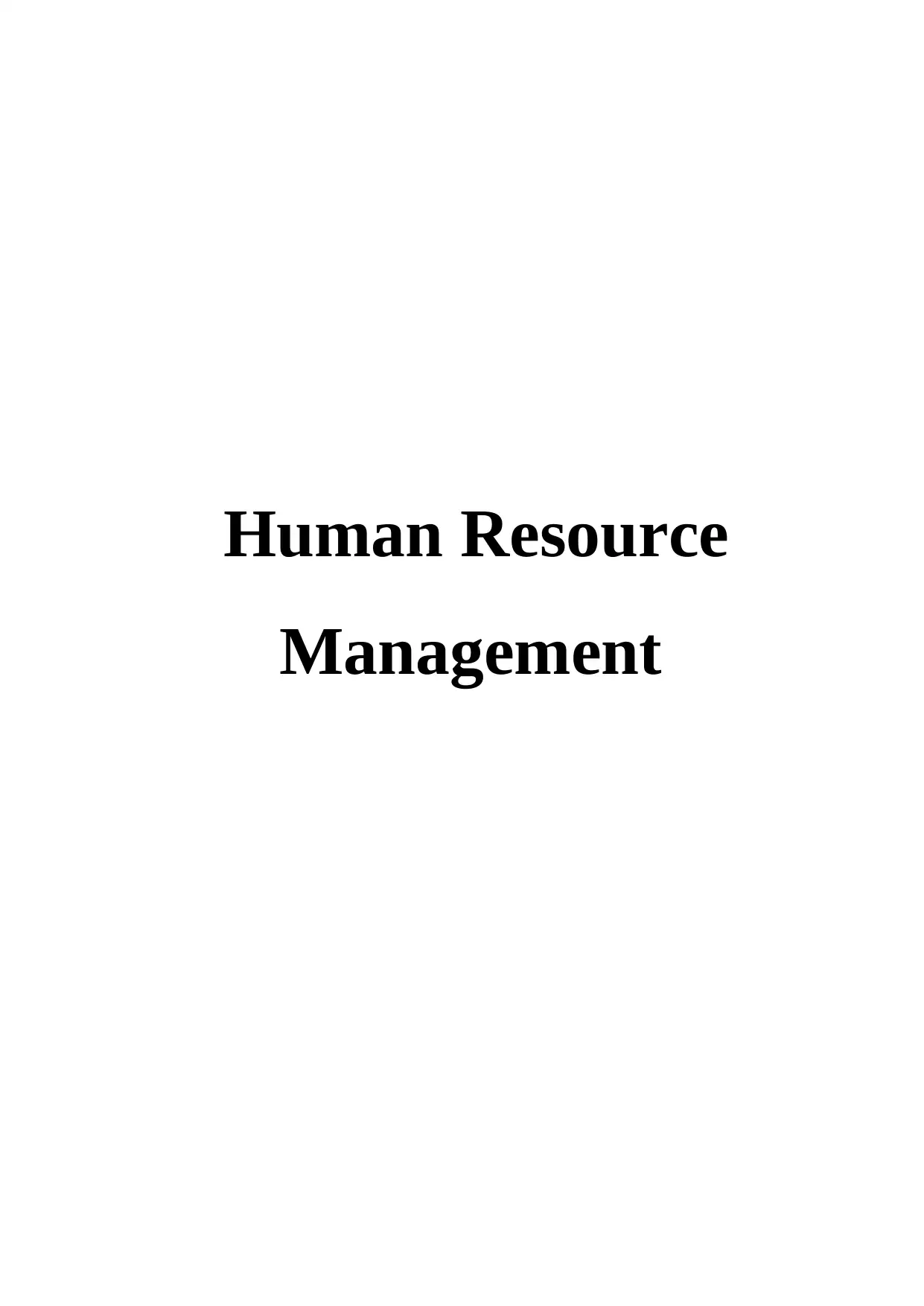
Human Resource
Management
Management
Secure Best Marks with AI Grader
Need help grading? Try our AI Grader for instant feedback on your assignments.
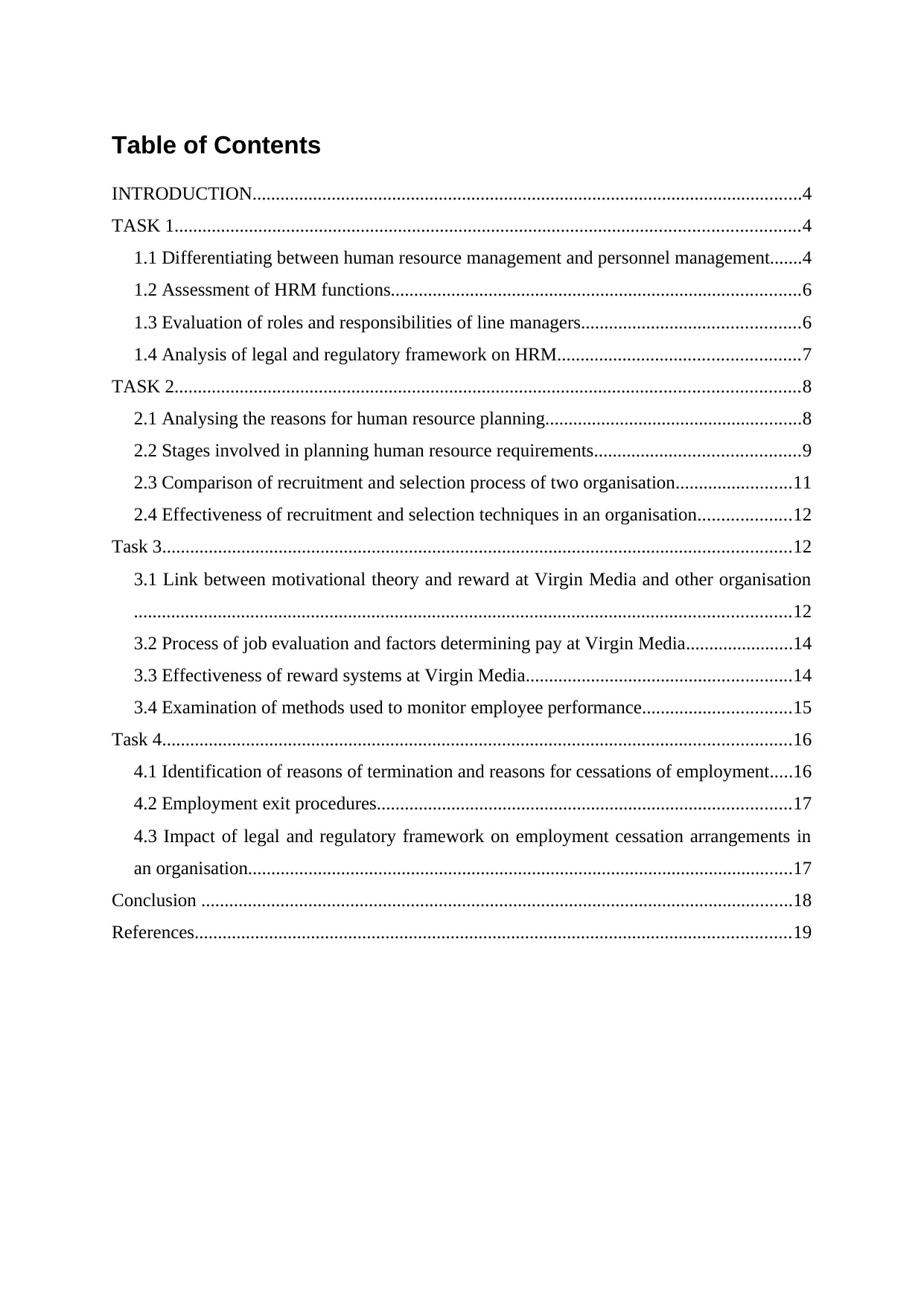
Table of Contents
INTRODUCTION......................................................................................................................4
TASK 1......................................................................................................................................4
1.1 Differentiating between human resource management and personnel management.......4
1.2 Assessment of HRM functions........................................................................................6
1.3 Evaluation of roles and responsibilities of line managers...............................................6
1.4 Analysis of legal and regulatory framework on HRM....................................................7
TASK 2......................................................................................................................................8
2.1 Analysing the reasons for human resource planning.......................................................8
2.2 Stages involved in planning human resource requirements............................................9
2.3 Comparison of recruitment and selection process of two organisation.........................11
2.4 Effectiveness of recruitment and selection techniques in an organisation....................12
Task 3.......................................................................................................................................12
3.1 Link between motivational theory and reward at Virgin Media and other organisation
.............................................................................................................................................12
3.2 Process of job evaluation and factors determining pay at Virgin Media.......................14
3.3 Effectiveness of reward systems at Virgin Media.........................................................14
3.4 Examination of methods used to monitor employee performance................................15
Task 4.......................................................................................................................................16
4.1 Identification of reasons of termination and reasons for cessations of employment.....16
4.2 Employment exit procedures.........................................................................................17
4.3 Impact of legal and regulatory framework on employment cessation arrangements in
an organisation.....................................................................................................................17
Conclusion ...............................................................................................................................18
References................................................................................................................................19
INTRODUCTION......................................................................................................................4
TASK 1......................................................................................................................................4
1.1 Differentiating between human resource management and personnel management.......4
1.2 Assessment of HRM functions........................................................................................6
1.3 Evaluation of roles and responsibilities of line managers...............................................6
1.4 Analysis of legal and regulatory framework on HRM....................................................7
TASK 2......................................................................................................................................8
2.1 Analysing the reasons for human resource planning.......................................................8
2.2 Stages involved in planning human resource requirements............................................9
2.3 Comparison of recruitment and selection process of two organisation.........................11
2.4 Effectiveness of recruitment and selection techniques in an organisation....................12
Task 3.......................................................................................................................................12
3.1 Link between motivational theory and reward at Virgin Media and other organisation
.............................................................................................................................................12
3.2 Process of job evaluation and factors determining pay at Virgin Media.......................14
3.3 Effectiveness of reward systems at Virgin Media.........................................................14
3.4 Examination of methods used to monitor employee performance................................15
Task 4.......................................................................................................................................16
4.1 Identification of reasons of termination and reasons for cessations of employment.....16
4.2 Employment exit procedures.........................................................................................17
4.3 Impact of legal and regulatory framework on employment cessation arrangements in
an organisation.....................................................................................................................17
Conclusion ...............................................................................................................................18
References................................................................................................................................19
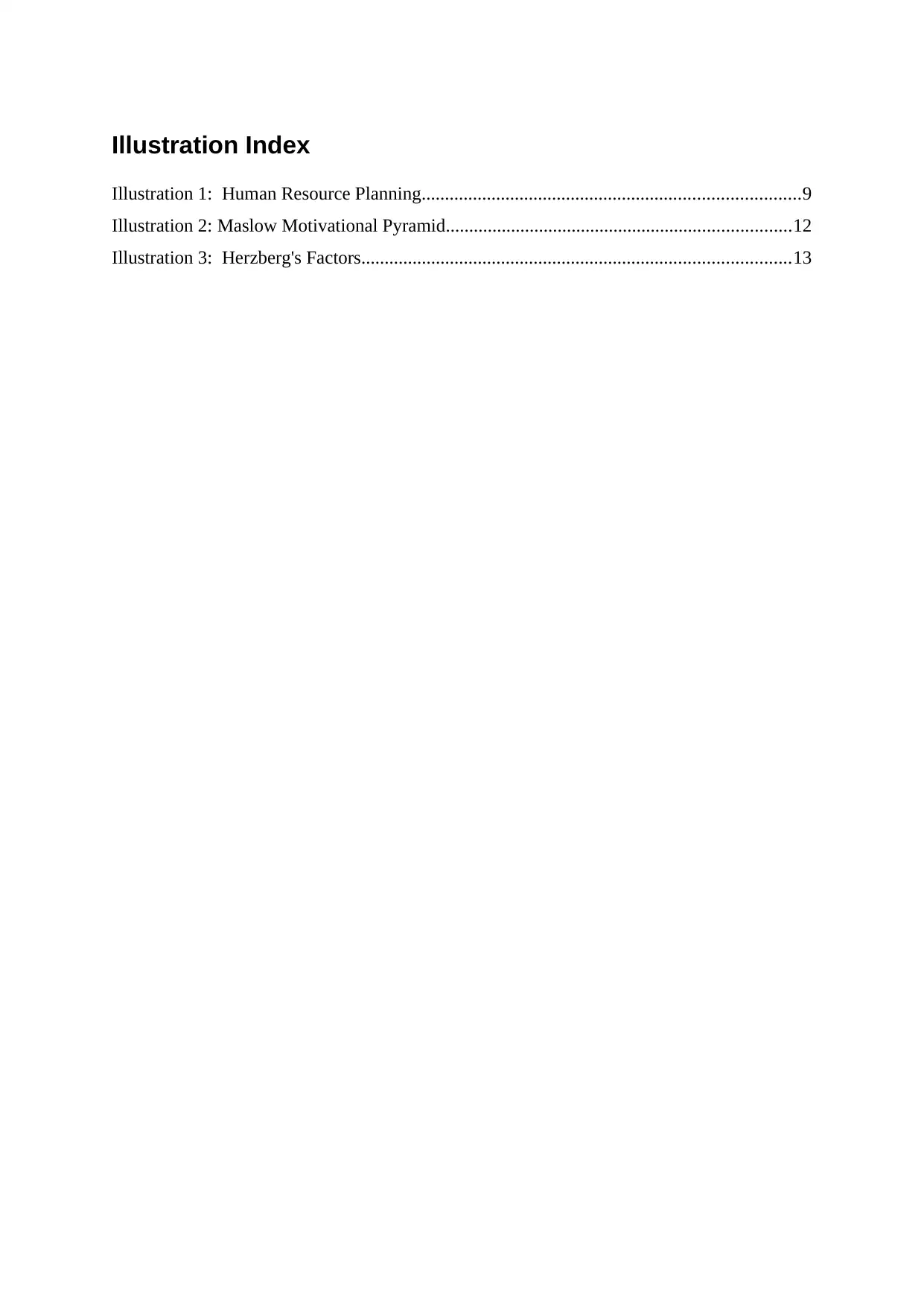
Illustration Index
Illustration 1: Human Resource Planning.................................................................................9
Illustration 2: Maslow Motivational Pyramid..........................................................................12
Illustration 3: Herzberg's Factors............................................................................................13
Illustration 1: Human Resource Planning.................................................................................9
Illustration 2: Maslow Motivational Pyramid..........................................................................12
Illustration 3: Herzberg's Factors............................................................................................13
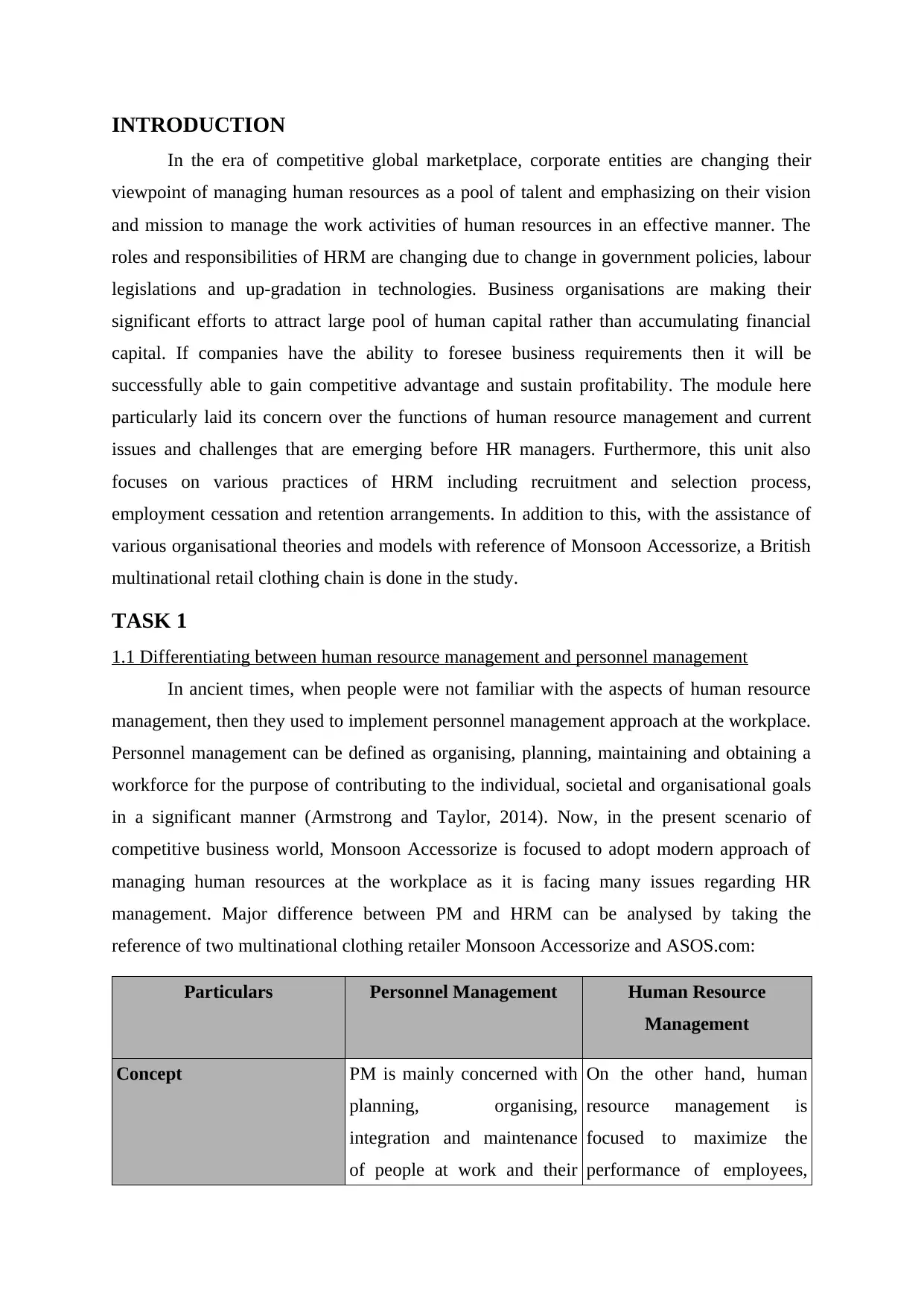
INTRODUCTION
In the era of competitive global marketplace, corporate entities are changing their
viewpoint of managing human resources as a pool of talent and emphasizing on their vision
and mission to manage the work activities of human resources in an effective manner. The
roles and responsibilities of HRM are changing due to change in government policies, labour
legislations and up-gradation in technologies. Business organisations are making their
significant efforts to attract large pool of human capital rather than accumulating financial
capital. If companies have the ability to foresee business requirements then it will be
successfully able to gain competitive advantage and sustain profitability. The module here
particularly laid its concern over the functions of human resource management and current
issues and challenges that are emerging before HR managers. Furthermore, this unit also
focuses on various practices of HRM including recruitment and selection process,
employment cessation and retention arrangements. In addition to this, with the assistance of
various organisational theories and models with reference of Monsoon Accessorize, a British
multinational retail clothing chain is done in the study.
TASK 1
1.1 Differentiating between human resource management and personnel management
In ancient times, when people were not familiar with the aspects of human resource
management, then they used to implement personnel management approach at the workplace.
Personnel management can be defined as organising, planning, maintaining and obtaining a
workforce for the purpose of contributing to the individual, societal and organisational goals
in a significant manner (Armstrong and Taylor, 2014). Now, in the present scenario of
competitive business world, Monsoon Accessorize is focused to adopt modern approach of
managing human resources at the workplace as it is facing many issues regarding HR
management. Major difference between PM and HRM can be analysed by taking the
reference of two multinational clothing retailer Monsoon Accessorize and ASOS.com:
Particulars Personnel Management Human Resource
Management
Concept PM is mainly concerned with
planning, organising,
integration and maintenance
of people at work and their
On the other hand, human
resource management is
focused to maximize the
performance of employees,
In the era of competitive global marketplace, corporate entities are changing their
viewpoint of managing human resources as a pool of talent and emphasizing on their vision
and mission to manage the work activities of human resources in an effective manner. The
roles and responsibilities of HRM are changing due to change in government policies, labour
legislations and up-gradation in technologies. Business organisations are making their
significant efforts to attract large pool of human capital rather than accumulating financial
capital. If companies have the ability to foresee business requirements then it will be
successfully able to gain competitive advantage and sustain profitability. The module here
particularly laid its concern over the functions of human resource management and current
issues and challenges that are emerging before HR managers. Furthermore, this unit also
focuses on various practices of HRM including recruitment and selection process,
employment cessation and retention arrangements. In addition to this, with the assistance of
various organisational theories and models with reference of Monsoon Accessorize, a British
multinational retail clothing chain is done in the study.
TASK 1
1.1 Differentiating between human resource management and personnel management
In ancient times, when people were not familiar with the aspects of human resource
management, then they used to implement personnel management approach at the workplace.
Personnel management can be defined as organising, planning, maintaining and obtaining a
workforce for the purpose of contributing to the individual, societal and organisational goals
in a significant manner (Armstrong and Taylor, 2014). Now, in the present scenario of
competitive business world, Monsoon Accessorize is focused to adopt modern approach of
managing human resources at the workplace as it is facing many issues regarding HR
management. Major difference between PM and HRM can be analysed by taking the
reference of two multinational clothing retailer Monsoon Accessorize and ASOS.com:
Particulars Personnel Management Human Resource
Management
Concept PM is mainly concerned with
planning, organising,
integration and maintenance
of people at work and their
On the other hand, human
resource management is
focused to maximize the
performance of employees,
Secure Best Marks with AI Grader
Need help grading? Try our AI Grader for instant feedback on your assignments.
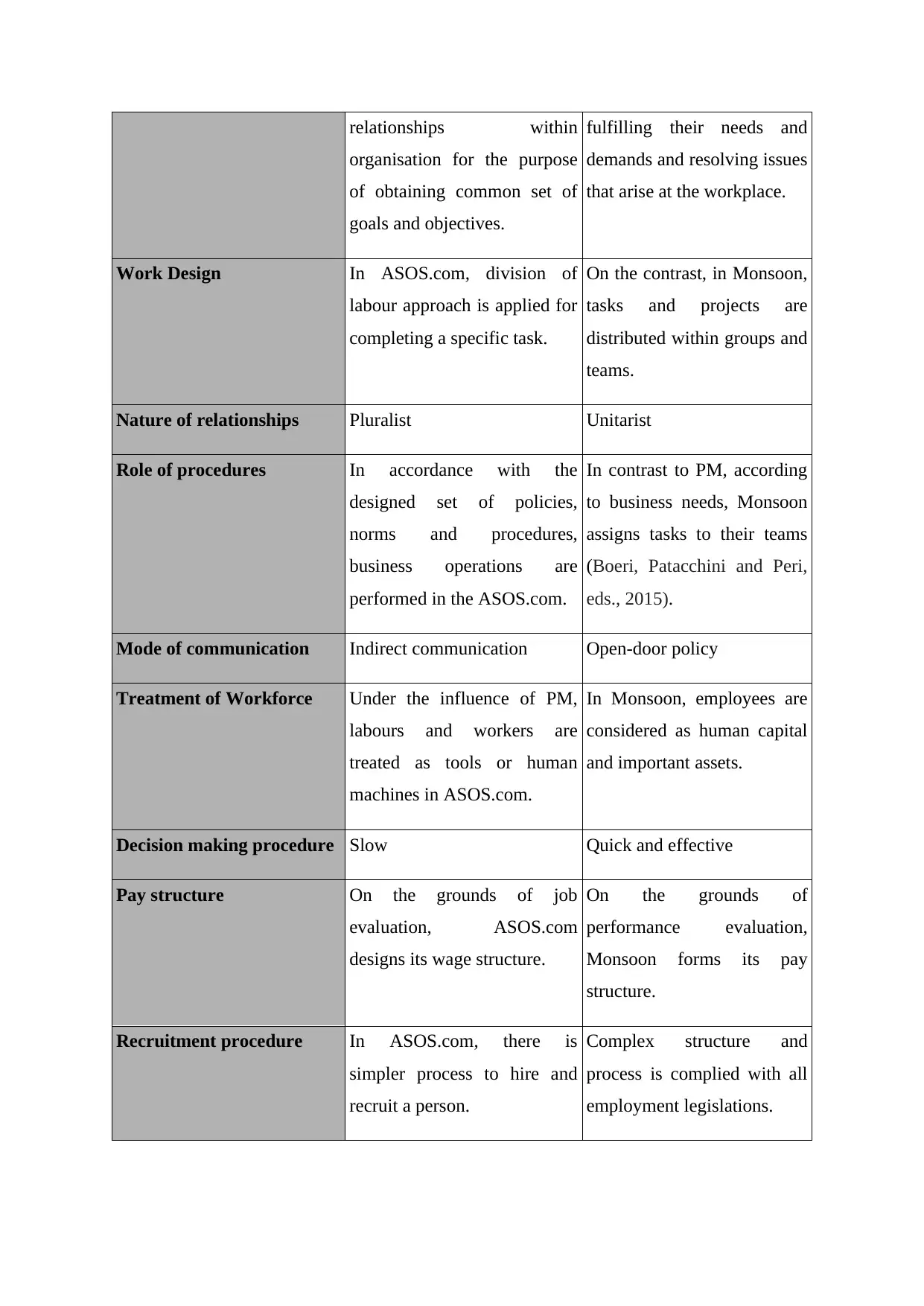
relationships within
organisation for the purpose
of obtaining common set of
goals and objectives.
fulfilling their needs and
demands and resolving issues
that arise at the workplace.
Work Design In ASOS.com, division of
labour approach is applied for
completing a specific task.
On the contrast, in Monsoon,
tasks and projects are
distributed within groups and
teams.
Nature of relationships Pluralist Unitarist
Role of procedures In accordance with the
designed set of policies,
norms and procedures,
business operations are
performed in the ASOS.com.
In contrast to PM, according
to business needs, Monsoon
assigns tasks to their teams
(Boeri, Patacchini and Peri,
eds., 2015).
Mode of communication Indirect communication Open-door policy
Treatment of Workforce Under the influence of PM,
labours and workers are
treated as tools or human
machines in ASOS.com.
In Monsoon, employees are
considered as human capital
and important assets.
Decision making procedure Slow Quick and effective
Pay structure On the grounds of job
evaluation, ASOS.com
designs its wage structure.
On the grounds of
performance evaluation,
Monsoon forms its pay
structure.
Recruitment procedure In ASOS.com, there is
simpler process to hire and
recruit a person.
Complex structure and
process is complied with all
employment legislations.
organisation for the purpose
of obtaining common set of
goals and objectives.
fulfilling their needs and
demands and resolving issues
that arise at the workplace.
Work Design In ASOS.com, division of
labour approach is applied for
completing a specific task.
On the contrast, in Monsoon,
tasks and projects are
distributed within groups and
teams.
Nature of relationships Pluralist Unitarist
Role of procedures In accordance with the
designed set of policies,
norms and procedures,
business operations are
performed in the ASOS.com.
In contrast to PM, according
to business needs, Monsoon
assigns tasks to their teams
(Boeri, Patacchini and Peri,
eds., 2015).
Mode of communication Indirect communication Open-door policy
Treatment of Workforce Under the influence of PM,
labours and workers are
treated as tools or human
machines in ASOS.com.
In Monsoon, employees are
considered as human capital
and important assets.
Decision making procedure Slow Quick and effective
Pay structure On the grounds of job
evaluation, ASOS.com
designs its wage structure.
On the grounds of
performance evaluation,
Monsoon forms its pay
structure.
Recruitment procedure In ASOS.com, there is
simpler process to hire and
recruit a person.
Complex structure and
process is complied with all
employment legislations.

With the above findings, it can be stated that human resource management is a better
approach than PM which can be understood by undertaking the differences between
personnel and human resource management (Armstrong and Taylor, 2014). HRM laid its
concern to attain desired objective by emphasising on the work performance and relationship
of employees at the workplace.
1.2 Assessment of HRM functions
Some key functions of HRM are discussed as below which can be undertaken by
Monsoon Accessorize Company in an effective manner: HR planning and organising: It is the foremost function of HRM to plan and organise
business activities of firm in an appropriate manner with the implications of
systematic procedures and policies. The Monsoon Company should determine its aim
and objectives which is to be attained by assessing various functions of HRM. Recruitment and selection procedures: HRM delivers significant value to the
Monsoon Accessorize by recruiting and selecting right candidates in the firm.
Moreover, it is also required to comply with all legislations and regulatory
frameworks at the workplace while recruiting people (Chang-Richards and et. al.,
2015). Training and Development sessions: The Monsoon Accessorize is also required to
conduct training and development sessions for their employees in order to train and
guide them according to the requirement of company (Armstrong and Taylor, 2014). Reward systems: Work performance of employees and their behaviour is rated in
organization according to which they are provided with substantial amount of
compensation, incentives and bonuses as well as leaves so that they can be motivated
and encouraged to work efficiently.
Maintenance: HRM system in Monsoon is also responsible to maintain the working
conditions, health and safety concerns of employees. Through thus, they can sense the
feel of comfort at workplace.
1.3 Evaluation of roles and responsibilities of line managers
Roles and responsibilities of line managers in Monsoon Accessorize
The line manager of company is responsible to set specific standards, benchmarks,
targets and deadlines of tasks so that efficiency of employees can be improved in an
effective manner.
approach than PM which can be understood by undertaking the differences between
personnel and human resource management (Armstrong and Taylor, 2014). HRM laid its
concern to attain desired objective by emphasising on the work performance and relationship
of employees at the workplace.
1.2 Assessment of HRM functions
Some key functions of HRM are discussed as below which can be undertaken by
Monsoon Accessorize Company in an effective manner: HR planning and organising: It is the foremost function of HRM to plan and organise
business activities of firm in an appropriate manner with the implications of
systematic procedures and policies. The Monsoon Company should determine its aim
and objectives which is to be attained by assessing various functions of HRM. Recruitment and selection procedures: HRM delivers significant value to the
Monsoon Accessorize by recruiting and selecting right candidates in the firm.
Moreover, it is also required to comply with all legislations and regulatory
frameworks at the workplace while recruiting people (Chang-Richards and et. al.,
2015). Training and Development sessions: The Monsoon Accessorize is also required to
conduct training and development sessions for their employees in order to train and
guide them according to the requirement of company (Armstrong and Taylor, 2014). Reward systems: Work performance of employees and their behaviour is rated in
organization according to which they are provided with substantial amount of
compensation, incentives and bonuses as well as leaves so that they can be motivated
and encouraged to work efficiently.
Maintenance: HRM system in Monsoon is also responsible to maintain the working
conditions, health and safety concerns of employees. Through thus, they can sense the
feel of comfort at workplace.
1.3 Evaluation of roles and responsibilities of line managers
Roles and responsibilities of line managers in Monsoon Accessorize
The line manager of company is responsible to set specific standards, benchmarks,
targets and deadlines of tasks so that efficiency of employees can be improved in an
effective manner.
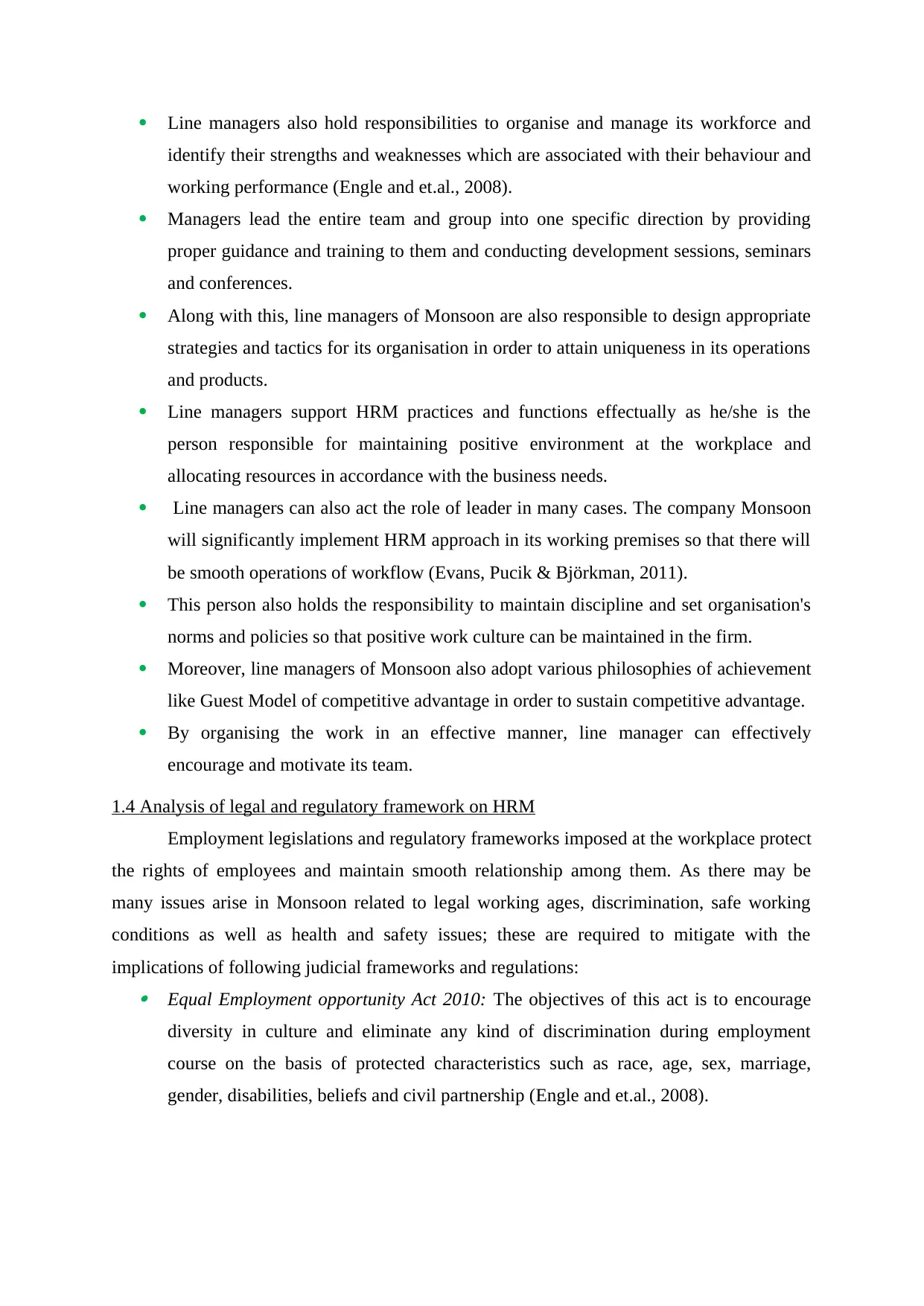
Line managers also hold responsibilities to organise and manage its workforce and
identify their strengths and weaknesses which are associated with their behaviour and
working performance (Engle and et.al., 2008).
Managers lead the entire team and group into one specific direction by providing
proper guidance and training to them and conducting development sessions, seminars
and conferences.
Along with this, line managers of Monsoon are also responsible to design appropriate
strategies and tactics for its organisation in order to attain uniqueness in its operations
and products.
Line managers support HRM practices and functions effectually as he/she is the
person responsible for maintaining positive environment at the workplace and
allocating resources in accordance with the business needs.
Line managers can also act the role of leader in many cases. The company Monsoon
will significantly implement HRM approach in its working premises so that there will
be smooth operations of workflow (Evans, Pucik & Björkman, 2011).
This person also holds the responsibility to maintain discipline and set organisation's
norms and policies so that positive work culture can be maintained in the firm.
Moreover, line managers of Monsoon also adopt various philosophies of achievement
like Guest Model of competitive advantage in order to sustain competitive advantage.
By organising the work in an effective manner, line manager can effectively
encourage and motivate its team.
1.4 Analysis of legal and regulatory framework on HRM
Employment legislations and regulatory frameworks imposed at the workplace protect
the rights of employees and maintain smooth relationship among them. As there may be
many issues arise in Monsoon related to legal working ages, discrimination, safe working
conditions as well as health and safety issues; these are required to mitigate with the
implications of following judicial frameworks and regulations: Equal Employment opportunity Act 2010: The objectives of this act is to encourage
diversity in culture and eliminate any kind of discrimination during employment
course on the basis of protected characteristics such as race, age, sex, marriage,
gender, disabilities, beliefs and civil partnership (Engle and et.al., 2008).
identify their strengths and weaknesses which are associated with their behaviour and
working performance (Engle and et.al., 2008).
Managers lead the entire team and group into one specific direction by providing
proper guidance and training to them and conducting development sessions, seminars
and conferences.
Along with this, line managers of Monsoon are also responsible to design appropriate
strategies and tactics for its organisation in order to attain uniqueness in its operations
and products.
Line managers support HRM practices and functions effectually as he/she is the
person responsible for maintaining positive environment at the workplace and
allocating resources in accordance with the business needs.
Line managers can also act the role of leader in many cases. The company Monsoon
will significantly implement HRM approach in its working premises so that there will
be smooth operations of workflow (Evans, Pucik & Björkman, 2011).
This person also holds the responsibility to maintain discipline and set organisation's
norms and policies so that positive work culture can be maintained in the firm.
Moreover, line managers of Monsoon also adopt various philosophies of achievement
like Guest Model of competitive advantage in order to sustain competitive advantage.
By organising the work in an effective manner, line manager can effectively
encourage and motivate its team.
1.4 Analysis of legal and regulatory framework on HRM
Employment legislations and regulatory frameworks imposed at the workplace protect
the rights of employees and maintain smooth relationship among them. As there may be
many issues arise in Monsoon related to legal working ages, discrimination, safe working
conditions as well as health and safety issues; these are required to mitigate with the
implications of following judicial frameworks and regulations: Equal Employment opportunity Act 2010: The objectives of this act is to encourage
diversity in culture and eliminate any kind of discrimination during employment
course on the basis of protected characteristics such as race, age, sex, marriage,
gender, disabilities, beliefs and civil partnership (Engle and et.al., 2008).
Paraphrase This Document
Need a fresh take? Get an instant paraphrase of this document with our AI Paraphraser
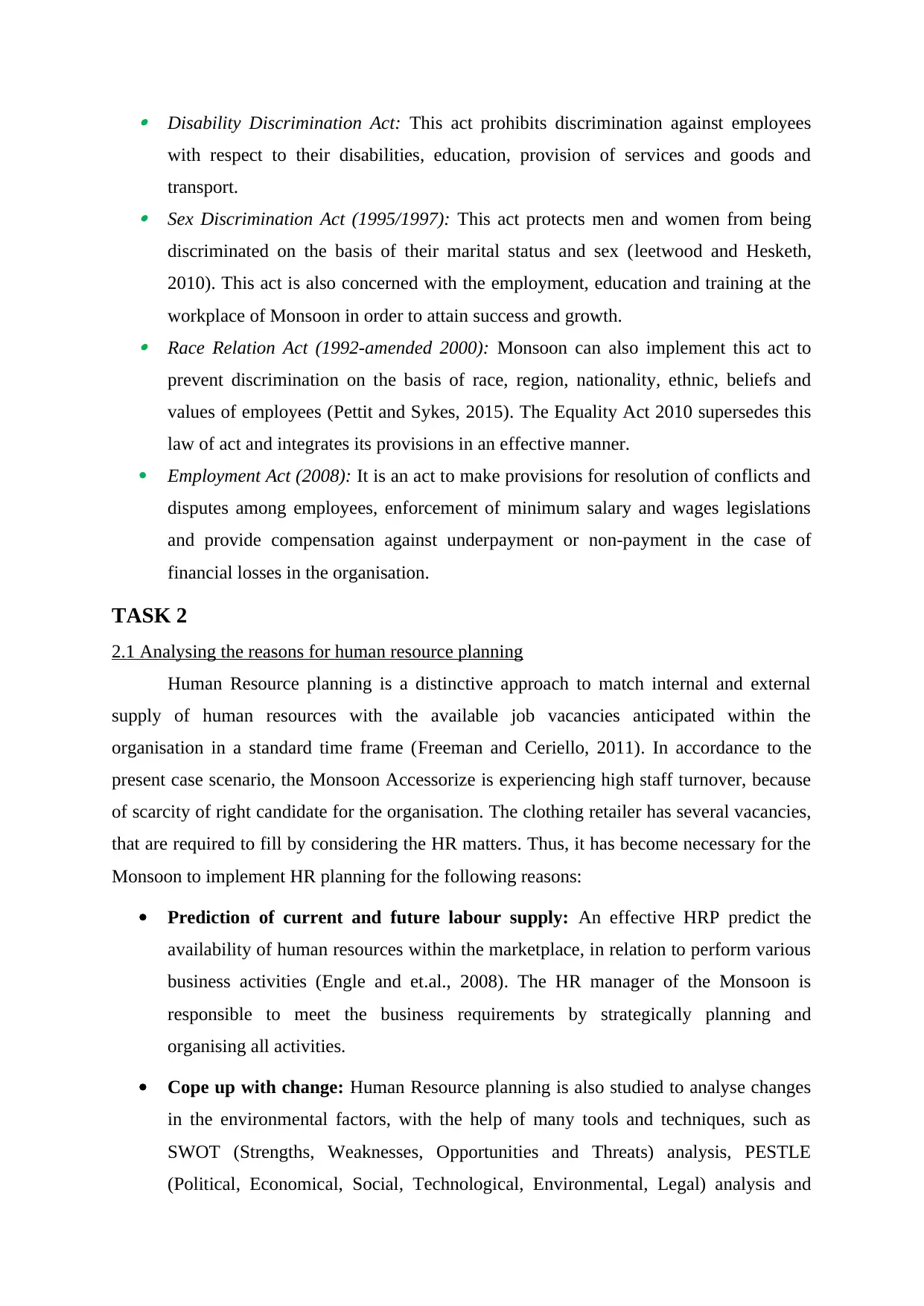
Disability Discrimination Act: This act prohibits discrimination against employees
with respect to their disabilities, education, provision of services and goods and
transport. Sex Discrimination Act (1995/1997): This act protects men and women from being
discriminated on the basis of their marital status and sex (leetwood and Hesketh,
2010). This act is also concerned with the employment, education and training at the
workplace of Monsoon in order to attain success and growth. Race Relation Act (1992-amended 2000): Monsoon can also implement this act to
prevent discrimination on the basis of race, region, nationality, ethnic, beliefs and
values of employees (Pettit and Sykes, 2015). The Equality Act 2010 supersedes this
law of act and integrates its provisions in an effective manner.
Employment Act (2008): It is an act to make provisions for resolution of conflicts and
disputes among employees, enforcement of minimum salary and wages legislations
and provide compensation against underpayment or non-payment in the case of
financial losses in the organisation.
TASK 2
2.1 Analysing the reasons for human resource planning
Human Resource planning is a distinctive approach to match internal and external
supply of human resources with the available job vacancies anticipated within the
organisation in a standard time frame (Freeman and Ceriello, 2011). In accordance to the
present case scenario, the Monsoon Accessorize is experiencing high staff turnover, because
of scarcity of right candidate for the organisation. The clothing retailer has several vacancies,
that are required to fill by considering the HR matters. Thus, it has become necessary for the
Monsoon to implement HR planning for the following reasons:
Prediction of current and future labour supply: An effective HRP predict the
availability of human resources within the marketplace, in relation to perform various
business activities (Engle and et.al., 2008). The HR manager of the Monsoon is
responsible to meet the business requirements by strategically planning and
organising all activities.
Cope up with change: Human Resource planning is also studied to analyse changes
in the environmental factors, with the help of many tools and techniques, such as
SWOT (Strengths, Weaknesses, Opportunities and Threats) analysis, PESTLE
(Political, Economical, Social, Technological, Environmental, Legal) analysis and
with respect to their disabilities, education, provision of services and goods and
transport. Sex Discrimination Act (1995/1997): This act protects men and women from being
discriminated on the basis of their marital status and sex (leetwood and Hesketh,
2010). This act is also concerned with the employment, education and training at the
workplace of Monsoon in order to attain success and growth. Race Relation Act (1992-amended 2000): Monsoon can also implement this act to
prevent discrimination on the basis of race, region, nationality, ethnic, beliefs and
values of employees (Pettit and Sykes, 2015). The Equality Act 2010 supersedes this
law of act and integrates its provisions in an effective manner.
Employment Act (2008): It is an act to make provisions for resolution of conflicts and
disputes among employees, enforcement of minimum salary and wages legislations
and provide compensation against underpayment or non-payment in the case of
financial losses in the organisation.
TASK 2
2.1 Analysing the reasons for human resource planning
Human Resource planning is a distinctive approach to match internal and external
supply of human resources with the available job vacancies anticipated within the
organisation in a standard time frame (Freeman and Ceriello, 2011). In accordance to the
present case scenario, the Monsoon Accessorize is experiencing high staff turnover, because
of scarcity of right candidate for the organisation. The clothing retailer has several vacancies,
that are required to fill by considering the HR matters. Thus, it has become necessary for the
Monsoon to implement HR planning for the following reasons:
Prediction of current and future labour supply: An effective HRP predict the
availability of human resources within the marketplace, in relation to perform various
business activities (Engle and et.al., 2008). The HR manager of the Monsoon is
responsible to meet the business requirements by strategically planning and
organising all activities.
Cope up with change: Human Resource planning is also studied to analyse changes
in the environmental factors, with the help of many tools and techniques, such as
SWOT (Strengths, Weaknesses, Opportunities and Threats) analysis, PESTLE
(Political, Economical, Social, Technological, Environmental, Legal) analysis and
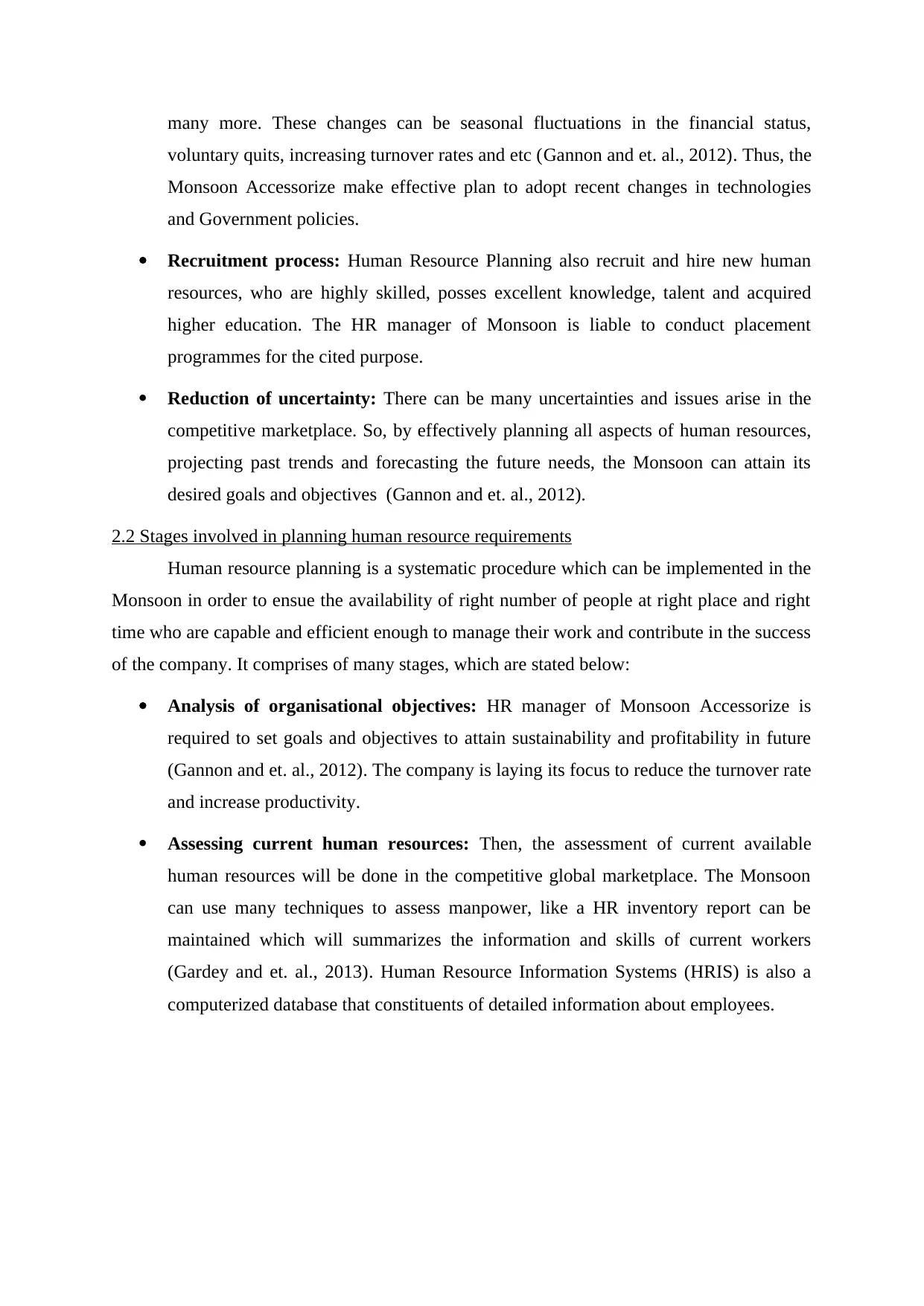
many more. These changes can be seasonal fluctuations in the financial status,
voluntary quits, increasing turnover rates and etc (Gannon and et. al., 2012). Thus, the
Monsoon Accessorize make effective plan to adopt recent changes in technologies
and Government policies.
Recruitment process: Human Resource Planning also recruit and hire new human
resources, who are highly skilled, posses excellent knowledge, talent and acquired
higher education. The HR manager of Monsoon is liable to conduct placement
programmes for the cited purpose.
Reduction of uncertainty: There can be many uncertainties and issues arise in the
competitive marketplace. So, by effectively planning all aspects of human resources,
projecting past trends and forecasting the future needs, the Monsoon can attain its
desired goals and objectives (Gannon and et. al., 2012).
2.2 Stages involved in planning human resource requirements
Human resource planning is a systematic procedure which can be implemented in the
Monsoon in order to ensue the availability of right number of people at right place and right
time who are capable and efficient enough to manage their work and contribute in the success
of the company. It comprises of many stages, which are stated below:
Analysis of organisational objectives: HR manager of Monsoon Accessorize is
required to set goals and objectives to attain sustainability and profitability in future
(Gannon and et. al., 2012). The company is laying its focus to reduce the turnover rate
and increase productivity.
Assessing current human resources: Then, the assessment of current available
human resources will be done in the competitive global marketplace. The Monsoon
can use many techniques to assess manpower, like a HR inventory report can be
maintained which will summarizes the information and skills of current workers
(Gardey and et. al., 2013). Human Resource Information Systems (HRIS) is also a
computerized database that constituents of detailed information about employees.
voluntary quits, increasing turnover rates and etc (Gannon and et. al., 2012). Thus, the
Monsoon Accessorize make effective plan to adopt recent changes in technologies
and Government policies.
Recruitment process: Human Resource Planning also recruit and hire new human
resources, who are highly skilled, posses excellent knowledge, talent and acquired
higher education. The HR manager of Monsoon is liable to conduct placement
programmes for the cited purpose.
Reduction of uncertainty: There can be many uncertainties and issues arise in the
competitive marketplace. So, by effectively planning all aspects of human resources,
projecting past trends and forecasting the future needs, the Monsoon can attain its
desired goals and objectives (Gannon and et. al., 2012).
2.2 Stages involved in planning human resource requirements
Human resource planning is a systematic procedure which can be implemented in the
Monsoon in order to ensue the availability of right number of people at right place and right
time who are capable and efficient enough to manage their work and contribute in the success
of the company. It comprises of many stages, which are stated below:
Analysis of organisational objectives: HR manager of Monsoon Accessorize is
required to set goals and objectives to attain sustainability and profitability in future
(Gannon and et. al., 2012). The company is laying its focus to reduce the turnover rate
and increase productivity.
Assessing current human resources: Then, the assessment of current available
human resources will be done in the competitive global marketplace. The Monsoon
can use many techniques to assess manpower, like a HR inventory report can be
maintained which will summarizes the information and skills of current workers
(Gardey and et. al., 2013). Human Resource Information Systems (HRIS) is also a
computerized database that constituents of detailed information about employees.
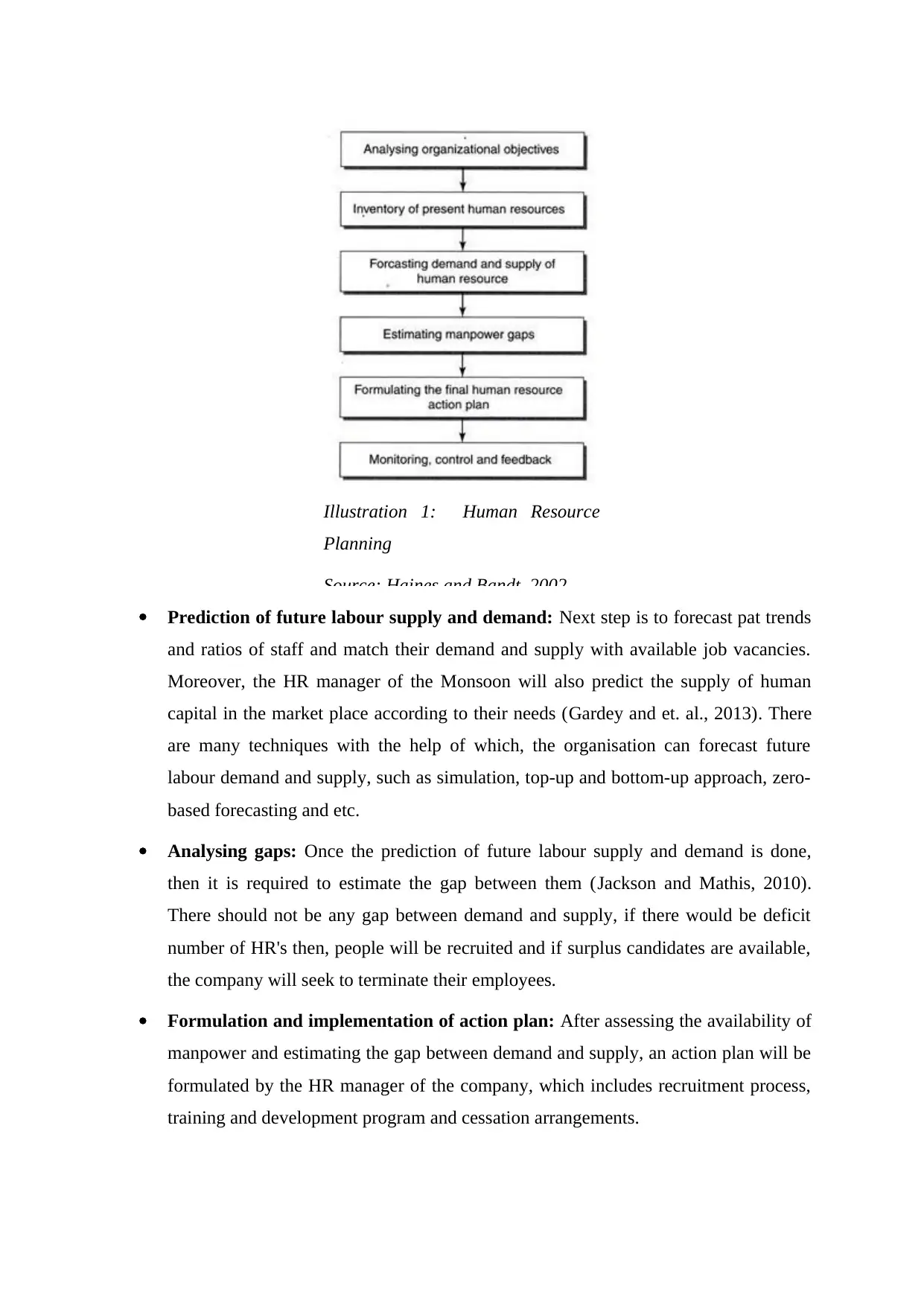
Illustration 1: Human Resource
Planning
Source: Haines and Bandt, 2002
Prediction of future labour supply and demand: Next step is to forecast pat trends
and ratios of staff and match their demand and supply with available job vacancies.
Moreover, the HR manager of the Monsoon will also predict the supply of human
capital in the market place according to their needs (Gardey and et. al., 2013). There
are many techniques with the help of which, the organisation can forecast future
labour demand and supply, such as simulation, top-up and bottom-up approach, zero-
based forecasting and etc.
Analysing gaps: Once the prediction of future labour supply and demand is done,
then it is required to estimate the gap between them (Jackson and Mathis, 2010).
There should not be any gap between demand and supply, if there would be deficit
number of HR's then, people will be recruited and if surplus candidates are available,
the company will seek to terminate their employees.
Formulation and implementation of action plan: After assessing the availability of
manpower and estimating the gap between demand and supply, an action plan will be
formulated by the HR manager of the company, which includes recruitment process,
training and development program and cessation arrangements.
Planning
Source: Haines and Bandt, 2002
Prediction of future labour supply and demand: Next step is to forecast pat trends
and ratios of staff and match their demand and supply with available job vacancies.
Moreover, the HR manager of the Monsoon will also predict the supply of human
capital in the market place according to their needs (Gardey and et. al., 2013). There
are many techniques with the help of which, the organisation can forecast future
labour demand and supply, such as simulation, top-up and bottom-up approach, zero-
based forecasting and etc.
Analysing gaps: Once the prediction of future labour supply and demand is done,
then it is required to estimate the gap between them (Jackson and Mathis, 2010).
There should not be any gap between demand and supply, if there would be deficit
number of HR's then, people will be recruited and if surplus candidates are available,
the company will seek to terminate their employees.
Formulation and implementation of action plan: After assessing the availability of
manpower and estimating the gap between demand and supply, an action plan will be
formulated by the HR manager of the company, which includes recruitment process,
training and development program and cessation arrangements.
Secure Best Marks with AI Grader
Need help grading? Try our AI Grader for instant feedback on your assignments.
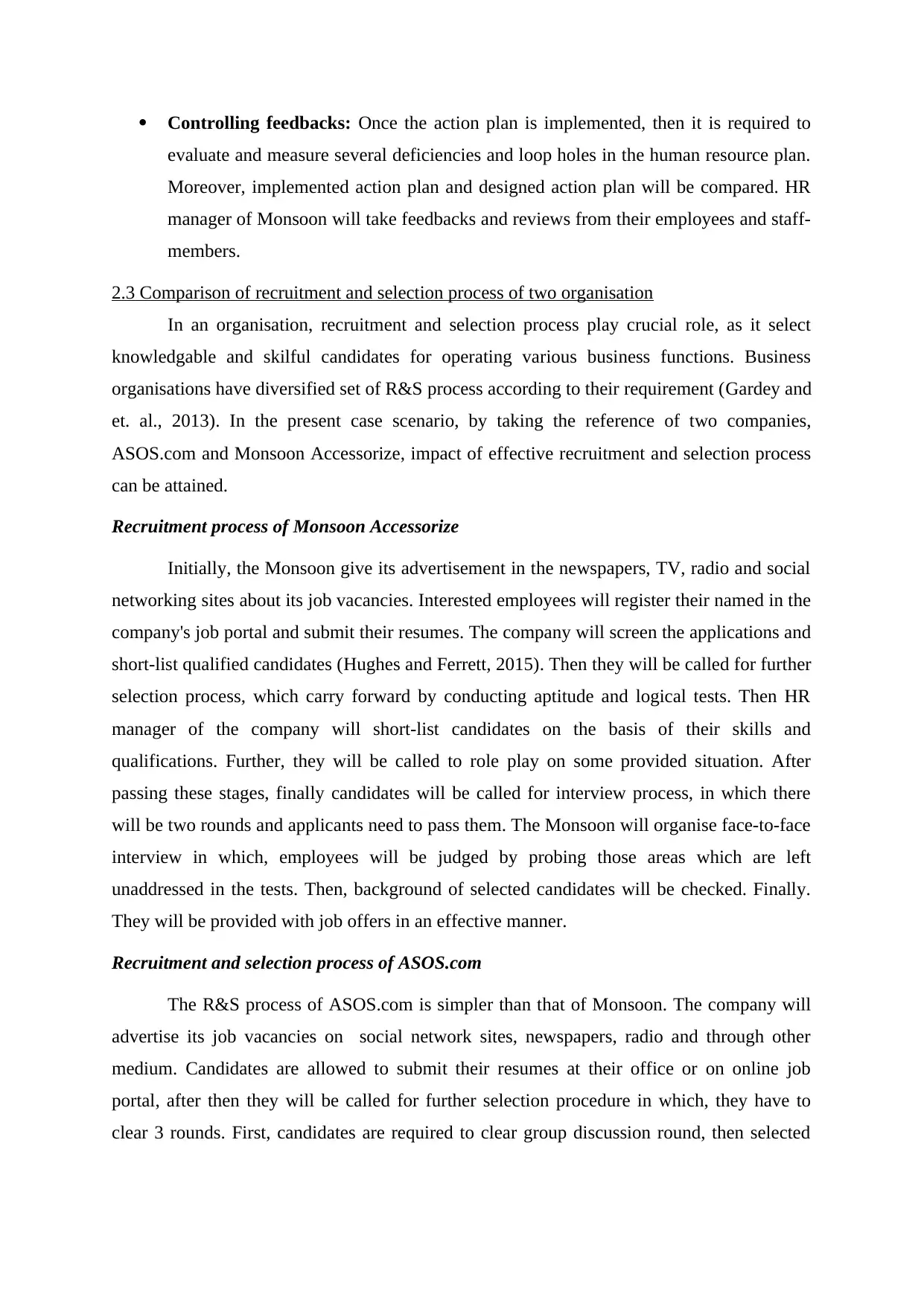
Controlling feedbacks: Once the action plan is implemented, then it is required to
evaluate and measure several deficiencies and loop holes in the human resource plan.
Moreover, implemented action plan and designed action plan will be compared. HR
manager of Monsoon will take feedbacks and reviews from their employees and staff-
members.
2.3 Comparison of recruitment and selection process of two organisation
In an organisation, recruitment and selection process play crucial role, as it select
knowledgable and skilful candidates for operating various business functions. Business
organisations have diversified set of R&S process according to their requirement (Gardey and
et. al., 2013). In the present case scenario, by taking the reference of two companies,
ASOS.com and Monsoon Accessorize, impact of effective recruitment and selection process
can be attained.
Recruitment process of Monsoon Accessorize
Initially, the Monsoon give its advertisement in the newspapers, TV, radio and social
networking sites about its job vacancies. Interested employees will register their named in the
company's job portal and submit their resumes. The company will screen the applications and
short-list qualified candidates (Hughes and Ferrett, 2015). Then they will be called for further
selection process, which carry forward by conducting aptitude and logical tests. Then HR
manager of the company will short-list candidates on the basis of their skills and
qualifications. Further, they will be called to role play on some provided situation. After
passing these stages, finally candidates will be called for interview process, in which there
will be two rounds and applicants need to pass them. The Monsoon will organise face-to-face
interview in which, employees will be judged by probing those areas which are left
unaddressed in the tests. Then, background of selected candidates will be checked. Finally.
They will be provided with job offers in an effective manner.
Recruitment and selection process of ASOS.com
The R&S process of ASOS.com is simpler than that of Monsoon. The company will
advertise its job vacancies on social network sites, newspapers, radio and through other
medium. Candidates are allowed to submit their resumes at their office or on online job
portal, after then they will be called for further selection procedure in which, they have to
clear 3 rounds. First, candidates are required to clear group discussion round, then selected
evaluate and measure several deficiencies and loop holes in the human resource plan.
Moreover, implemented action plan and designed action plan will be compared. HR
manager of Monsoon will take feedbacks and reviews from their employees and staff-
members.
2.3 Comparison of recruitment and selection process of two organisation
In an organisation, recruitment and selection process play crucial role, as it select
knowledgable and skilful candidates for operating various business functions. Business
organisations have diversified set of R&S process according to their requirement (Gardey and
et. al., 2013). In the present case scenario, by taking the reference of two companies,
ASOS.com and Monsoon Accessorize, impact of effective recruitment and selection process
can be attained.
Recruitment process of Monsoon Accessorize
Initially, the Monsoon give its advertisement in the newspapers, TV, radio and social
networking sites about its job vacancies. Interested employees will register their named in the
company's job portal and submit their resumes. The company will screen the applications and
short-list qualified candidates (Hughes and Ferrett, 2015). Then they will be called for further
selection process, which carry forward by conducting aptitude and logical tests. Then HR
manager of the company will short-list candidates on the basis of their skills and
qualifications. Further, they will be called to role play on some provided situation. After
passing these stages, finally candidates will be called for interview process, in which there
will be two rounds and applicants need to pass them. The Monsoon will organise face-to-face
interview in which, employees will be judged by probing those areas which are left
unaddressed in the tests. Then, background of selected candidates will be checked. Finally.
They will be provided with job offers in an effective manner.
Recruitment and selection process of ASOS.com
The R&S process of ASOS.com is simpler than that of Monsoon. The company will
advertise its job vacancies on social network sites, newspapers, radio and through other
medium. Candidates are allowed to submit their resumes at their office or on online job
portal, after then they will be called for further selection procedure in which, they have to
clear 3 rounds. First, candidates are required to clear group discussion round, then selected
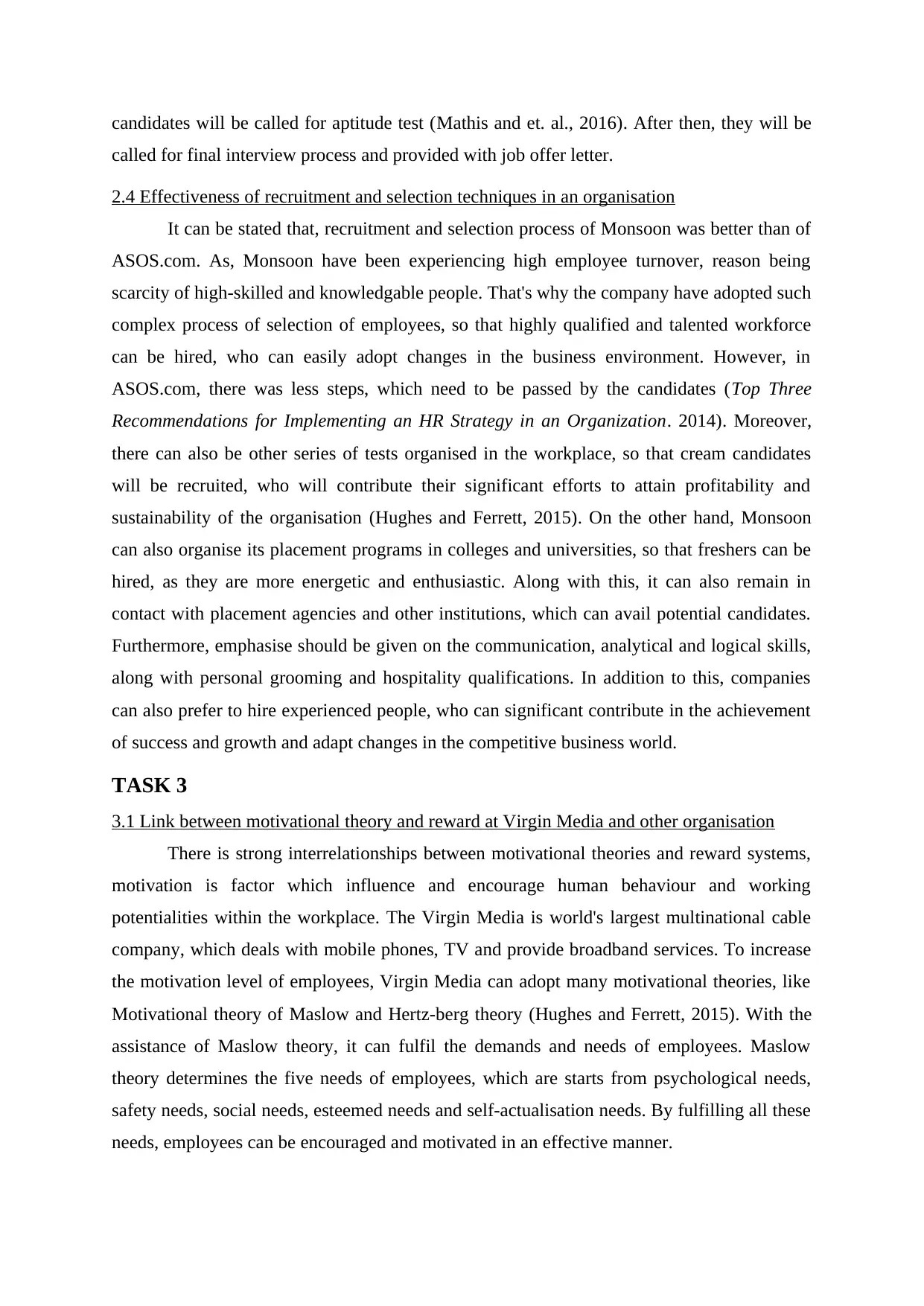
candidates will be called for aptitude test (Mathis and et. al., 2016). After then, they will be
called for final interview process and provided with job offer letter.
2.4 Effectiveness of recruitment and selection techniques in an organisation
It can be stated that, recruitment and selection process of Monsoon was better than of
ASOS.com. As, Monsoon have been experiencing high employee turnover, reason being
scarcity of high-skilled and knowledgable people. That's why the company have adopted such
complex process of selection of employees, so that highly qualified and talented workforce
can be hired, who can easily adopt changes in the business environment. However, in
ASOS.com, there was less steps, which need to be passed by the candidates (Top Three
Recommendations for Implementing an HR Strategy in an Organization. 2014). Moreover,
there can also be other series of tests organised in the workplace, so that cream candidates
will be recruited, who will contribute their significant efforts to attain profitability and
sustainability of the organisation (Hughes and Ferrett, 2015). On the other hand, Monsoon
can also organise its placement programs in colleges and universities, so that freshers can be
hired, as they are more energetic and enthusiastic. Along with this, it can also remain in
contact with placement agencies and other institutions, which can avail potential candidates.
Furthermore, emphasise should be given on the communication, analytical and logical skills,
along with personal grooming and hospitality qualifications. In addition to this, companies
can also prefer to hire experienced people, who can significant contribute in the achievement
of success and growth and adapt changes in the competitive business world.
TASK 3
3.1 Link between motivational theory and reward at Virgin Media and other organisation
There is strong interrelationships between motivational theories and reward systems,
motivation is factor which influence and encourage human behaviour and working
potentialities within the workplace. The Virgin Media is world's largest multinational cable
company, which deals with mobile phones, TV and provide broadband services. To increase
the motivation level of employees, Virgin Media can adopt many motivational theories, like
Motivational theory of Maslow and Hertz-berg theory (Hughes and Ferrett, 2015). With the
assistance of Maslow theory, it can fulfil the demands and needs of employees. Maslow
theory determines the five needs of employees, which are starts from psychological needs,
safety needs, social needs, esteemed needs and self-actualisation needs. By fulfilling all these
needs, employees can be encouraged and motivated in an effective manner.
called for final interview process and provided with job offer letter.
2.4 Effectiveness of recruitment and selection techniques in an organisation
It can be stated that, recruitment and selection process of Monsoon was better than of
ASOS.com. As, Monsoon have been experiencing high employee turnover, reason being
scarcity of high-skilled and knowledgable people. That's why the company have adopted such
complex process of selection of employees, so that highly qualified and talented workforce
can be hired, who can easily adopt changes in the business environment. However, in
ASOS.com, there was less steps, which need to be passed by the candidates (Top Three
Recommendations for Implementing an HR Strategy in an Organization. 2014). Moreover,
there can also be other series of tests organised in the workplace, so that cream candidates
will be recruited, who will contribute their significant efforts to attain profitability and
sustainability of the organisation (Hughes and Ferrett, 2015). On the other hand, Monsoon
can also organise its placement programs in colleges and universities, so that freshers can be
hired, as they are more energetic and enthusiastic. Along with this, it can also remain in
contact with placement agencies and other institutions, which can avail potential candidates.
Furthermore, emphasise should be given on the communication, analytical and logical skills,
along with personal grooming and hospitality qualifications. In addition to this, companies
can also prefer to hire experienced people, who can significant contribute in the achievement
of success and growth and adapt changes in the competitive business world.
TASK 3
3.1 Link between motivational theory and reward at Virgin Media and other organisation
There is strong interrelationships between motivational theories and reward systems,
motivation is factor which influence and encourage human behaviour and working
potentialities within the workplace. The Virgin Media is world's largest multinational cable
company, which deals with mobile phones, TV and provide broadband services. To increase
the motivation level of employees, Virgin Media can adopt many motivational theories, like
Motivational theory of Maslow and Hertz-berg theory (Hughes and Ferrett, 2015). With the
assistance of Maslow theory, it can fulfil the demands and needs of employees. Maslow
theory determines the five needs of employees, which are starts from psychological needs,
safety needs, social needs, esteemed needs and self-actualisation needs. By fulfilling all these
needs, employees can be encouraged and motivated in an effective manner.

On the other hand, the Monsoon can implement Herzberg's theory, which revealed the
motivation-Hygiene factors. Employees can be motivated by fulfilling the following factors:
Hygiene Factors Motivation factors
By providing positive working conditions,
job security, quality of supervisions and
effective company policies, the Monsoon can
increase the morale of employees (Role of
HRM. 2013).
Along with this, several motivational factors,
like providing opportunities, responsibilities,
promotion and personal growth opportunity,
employees can effectively encouraged and
motivated towards their work.
Illustration 2: Maslow Motivational Pyramid
Source: Gardey and et. al., 2013
motivation-Hygiene factors. Employees can be motivated by fulfilling the following factors:
Hygiene Factors Motivation factors
By providing positive working conditions,
job security, quality of supervisions and
effective company policies, the Monsoon can
increase the morale of employees (Role of
HRM. 2013).
Along with this, several motivational factors,
like providing opportunities, responsibilities,
promotion and personal growth opportunity,
employees can effectively encouraged and
motivated towards their work.
Illustration 2: Maslow Motivational Pyramid
Source: Gardey and et. al., 2013
Paraphrase This Document
Need a fresh take? Get an instant paraphrase of this document with our AI Paraphraser
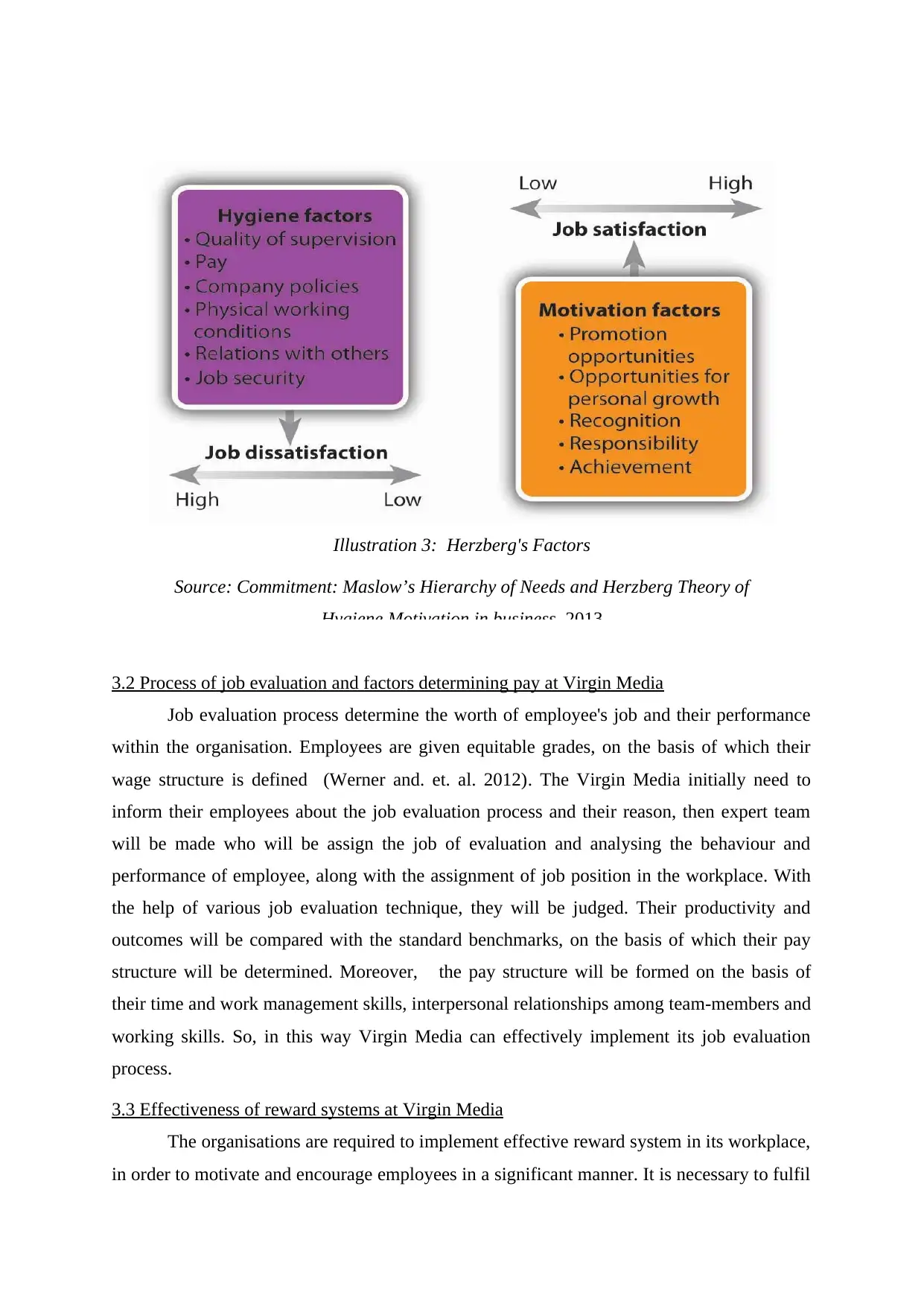
3.2 Process of job evaluation and factors determining pay at Virgin Media
Job evaluation process determine the worth of employee's job and their performance
within the organisation. Employees are given equitable grades, on the basis of which their
wage structure is defined (Werner and. et. al. 2012). The Virgin Media initially need to
inform their employees about the job evaluation process and their reason, then expert team
will be made who will be assign the job of evaluation and analysing the behaviour and
performance of employee, along with the assignment of job position in the workplace. With
the help of various job evaluation technique, they will be judged. Their productivity and
outcomes will be compared with the standard benchmarks, on the basis of which their pay
structure will be determined. Moreover, the pay structure will be formed on the basis of
their time and work management skills, interpersonal relationships among team-members and
working skills. So, in this way Virgin Media can effectively implement its job evaluation
process.
3.3 Effectiveness of reward systems at Virgin Media
The organisations are required to implement effective reward system in its workplace,
in order to motivate and encourage employees in a significant manner. It is necessary to fulfil
Illustration 3: Herzberg's Factors
Source: Commitment: Maslow’s Hierarchy of Needs and Herzberg Theory of
Hygiene Motivation in business. 2013
Job evaluation process determine the worth of employee's job and their performance
within the organisation. Employees are given equitable grades, on the basis of which their
wage structure is defined (Werner and. et. al. 2012). The Virgin Media initially need to
inform their employees about the job evaluation process and their reason, then expert team
will be made who will be assign the job of evaluation and analysing the behaviour and
performance of employee, along with the assignment of job position in the workplace. With
the help of various job evaluation technique, they will be judged. Their productivity and
outcomes will be compared with the standard benchmarks, on the basis of which their pay
structure will be determined. Moreover, the pay structure will be formed on the basis of
their time and work management skills, interpersonal relationships among team-members and
working skills. So, in this way Virgin Media can effectively implement its job evaluation
process.
3.3 Effectiveness of reward systems at Virgin Media
The organisations are required to implement effective reward system in its workplace,
in order to motivate and encourage employees in a significant manner. It is necessary to fulfil
Illustration 3: Herzberg's Factors
Source: Commitment: Maslow’s Hierarchy of Needs and Herzberg Theory of
Hygiene Motivation in business. 2013

the demands and needs of employees, as they provide their full contribution in the attainment
of set of goals and objectives. The effectiveness of reward system of Virgin Media and
Monsoon can be discussed below:
Effectiveness of reward system in Monsoon Accessorize
The HR manager of Monsoon can motivate their employees by providing intangible
rewards, which are popularly known as intrinsic reward systems. Here employee's
performance will recognised and they will be provided with more responsibilities and several
facilities like, impressive titles, parking spaces, cab facilities (Werner and. et. al. 2012).
Along with this, their work will also be analysed on the basis of efficiency and quality of
work. Moreover, they can also be facilitated with monetary rewards, like commissions,
incentives, merit pay schemes and etc., so that employees can feel motivated and encouraged.
They can increase their productivity and significantly contribute in the success of the
Monsoon Accessorize.
Effectiveness of reward system in Virgin Media
The Virgin Media can motivate their employees by providing them great career
opportunities in future (Werner and. et. al. 2012). The HR manager of the company is
required to conduct reward systems, in which employees are provided with monetary
benefits, such as bonuses, salary rise, gift vouchers, compensation holidays and many more.
It can also influence them and raise their morale by appreciating them and providing more
opportunities.
3.4 Examination of methods used to monitor employee performance
Performance management is a systematic approach of evaluation of work
performance of groups and individuals within the workplace, so as to improve their efficiency
and quality of work for accomplishment of organisational purposes goals and objectives.
There are various methods and techniques are available, that can be adopted by the Virgin
Media and Monsoon in the performance evaluation (Stockdale and Kühne, 2007). Some of
them are mentioned below: Performance Reviews: The HR manager of Virgin Media can evaluate the
performance of employees with the help of many techniques and tools, such as self-
monitoring tools, checklists and etc. which keep the track of employee's absentism,
performance and their behaviour.
of set of goals and objectives. The effectiveness of reward system of Virgin Media and
Monsoon can be discussed below:
Effectiveness of reward system in Monsoon Accessorize
The HR manager of Monsoon can motivate their employees by providing intangible
rewards, which are popularly known as intrinsic reward systems. Here employee's
performance will recognised and they will be provided with more responsibilities and several
facilities like, impressive titles, parking spaces, cab facilities (Werner and. et. al. 2012).
Along with this, their work will also be analysed on the basis of efficiency and quality of
work. Moreover, they can also be facilitated with monetary rewards, like commissions,
incentives, merit pay schemes and etc., so that employees can feel motivated and encouraged.
They can increase their productivity and significantly contribute in the success of the
Monsoon Accessorize.
Effectiveness of reward system in Virgin Media
The Virgin Media can motivate their employees by providing them great career
opportunities in future (Werner and. et. al. 2012). The HR manager of the company is
required to conduct reward systems, in which employees are provided with monetary
benefits, such as bonuses, salary rise, gift vouchers, compensation holidays and many more.
It can also influence them and raise their morale by appreciating them and providing more
opportunities.
3.4 Examination of methods used to monitor employee performance
Performance management is a systematic approach of evaluation of work
performance of groups and individuals within the workplace, so as to improve their efficiency
and quality of work for accomplishment of organisational purposes goals and objectives.
There are various methods and techniques are available, that can be adopted by the Virgin
Media and Monsoon in the performance evaluation (Stockdale and Kühne, 2007). Some of
them are mentioned below: Performance Reviews: The HR manager of Virgin Media can evaluate the
performance of employees with the help of many techniques and tools, such as self-
monitoring tools, checklists and etc. which keep the track of employee's absentism,
performance and their behaviour.
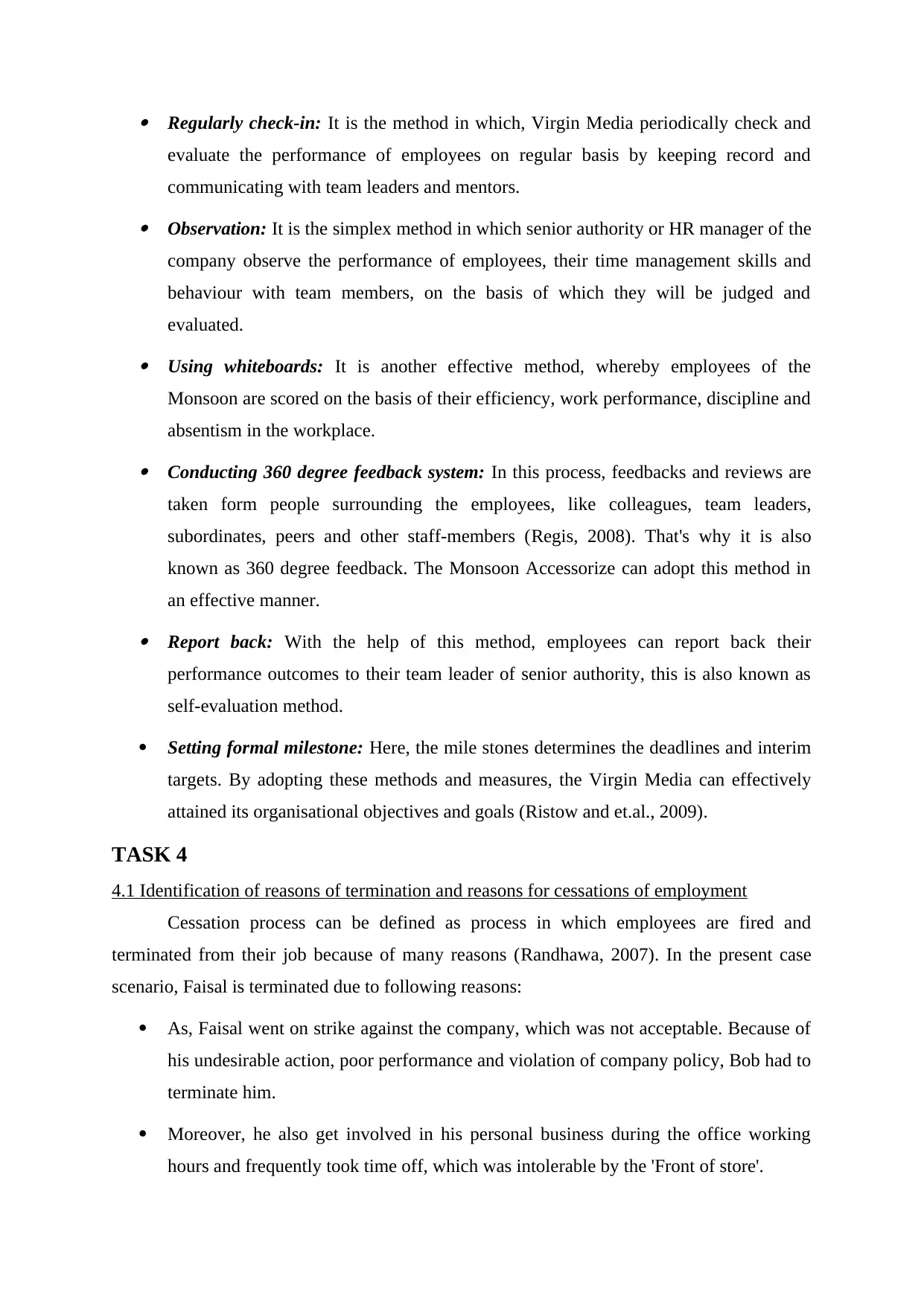
Regularly check-in: It is the method in which, Virgin Media periodically check and
evaluate the performance of employees on regular basis by keeping record and
communicating with team leaders and mentors. Observation: It is the simplex method in which senior authority or HR manager of the
company observe the performance of employees, their time management skills and
behaviour with team members, on the basis of which they will be judged and
evaluated. Using whiteboards: It is another effective method, whereby employees of the
Monsoon are scored on the basis of their efficiency, work performance, discipline and
absentism in the workplace. Conducting 360 degree feedback system: In this process, feedbacks and reviews are
taken form people surrounding the employees, like colleagues, team leaders,
subordinates, peers and other staff-members (Regis, 2008). That's why it is also
known as 360 degree feedback. The Monsoon Accessorize can adopt this method in
an effective manner. Report back: With the help of this method, employees can report back their
performance outcomes to their team leader of senior authority, this is also known as
self-evaluation method.
Setting formal milestone: Here, the mile stones determines the deadlines and interim
targets. By adopting these methods and measures, the Virgin Media can effectively
attained its organisational objectives and goals (Ristow and et.al., 2009).
TASK 4
4.1 Identification of reasons of termination and reasons for cessations of employment
Cessation process can be defined as process in which employees are fired and
terminated from their job because of many reasons (Randhawa, 2007). In the present case
scenario, Faisal is terminated due to following reasons:
As, Faisal went on strike against the company, which was not acceptable. Because of
his undesirable action, poor performance and violation of company policy, Bob had to
terminate him.
Moreover, he also get involved in his personal business during the office working
hours and frequently took time off, which was intolerable by the 'Front of store'.
evaluate the performance of employees on regular basis by keeping record and
communicating with team leaders and mentors. Observation: It is the simplex method in which senior authority or HR manager of the
company observe the performance of employees, their time management skills and
behaviour with team members, on the basis of which they will be judged and
evaluated. Using whiteboards: It is another effective method, whereby employees of the
Monsoon are scored on the basis of their efficiency, work performance, discipline and
absentism in the workplace. Conducting 360 degree feedback system: In this process, feedbacks and reviews are
taken form people surrounding the employees, like colleagues, team leaders,
subordinates, peers and other staff-members (Regis, 2008). That's why it is also
known as 360 degree feedback. The Monsoon Accessorize can adopt this method in
an effective manner. Report back: With the help of this method, employees can report back their
performance outcomes to their team leader of senior authority, this is also known as
self-evaluation method.
Setting formal milestone: Here, the mile stones determines the deadlines and interim
targets. By adopting these methods and measures, the Virgin Media can effectively
attained its organisational objectives and goals (Ristow and et.al., 2009).
TASK 4
4.1 Identification of reasons of termination and reasons for cessations of employment
Cessation process can be defined as process in which employees are fired and
terminated from their job because of many reasons (Randhawa, 2007). In the present case
scenario, Faisal is terminated due to following reasons:
As, Faisal went on strike against the company, which was not acceptable. Because of
his undesirable action, poor performance and violation of company policy, Bob had to
terminate him.
Moreover, he also get involved in his personal business during the office working
hours and frequently took time off, which was intolerable by the 'Front of store'.
Secure Best Marks with AI Grader
Need help grading? Try our AI Grader for instant feedback on your assignments.

Faisal was also responsible for his careless behaviour, while arranging foods and
cleaning kitchen. At many times, he was not able to avail food to customers, which
was completely unbearable by the Bob. Thus, as he did not adhere by company's
policies and norms, so he was fired.
All these above cited aspects, clearly stated that Faisal did not complied all employment
legislations and regulations, henceforth Chicken Master, Bob had to terminate him from his
duties and responsibilities.
4.2 Employment exit procedures
Employment exit procedure is referred as process which an organisation need to
undergo when an employee leave the office. Exit procedure of Chicken Master and Murano
restaurant:
Exit procedure of Chicken Master Exit Procedure of Murano
Initially, employees of the Chicken Master
need to give prior leaving notice to the
company, the time period of this notice will
be of 15 days. In this restaurant, exit
interview will be organised to examine the
relevant reasons of leaving job. The HR
manager of the company will influence them,
in order to retain in the job (Brookins, 2016).
In Murano restaurant, employees need to
serve prior notice of 30 days, if they seek to
leave the company. Then, a standard exit
checklist will be formed, in order to analyse
the roles and responsibilities of employees.
Then an exit process will be conducted, in
order to know the reason behind leaving
office. Then, employees are convinced to
remain the organisation and promised to
provide better opportunities (Ristow and
et.al., 2009).
4.3 Impact of legal and regulatory framework on employment cessation arrangements in an
organisation
There are various regulations and laws are there, which deal with the employment
cessation arrangements within the organisation. In accordance to provided case study, Faisal
needed to provide prior notice to Bob as per the Employment Law, 1996 (Pettit and Sykes,
2015). Bob owe the duty and obligation to comply with all terms and conditions of
employment law. Moreover, according to the case scenario, Faisal filed the complaint against
cleaning kitchen. At many times, he was not able to avail food to customers, which
was completely unbearable by the Bob. Thus, as he did not adhere by company's
policies and norms, so he was fired.
All these above cited aspects, clearly stated that Faisal did not complied all employment
legislations and regulations, henceforth Chicken Master, Bob had to terminate him from his
duties and responsibilities.
4.2 Employment exit procedures
Employment exit procedure is referred as process which an organisation need to
undergo when an employee leave the office. Exit procedure of Chicken Master and Murano
restaurant:
Exit procedure of Chicken Master Exit Procedure of Murano
Initially, employees of the Chicken Master
need to give prior leaving notice to the
company, the time period of this notice will
be of 15 days. In this restaurant, exit
interview will be organised to examine the
relevant reasons of leaving job. The HR
manager of the company will influence them,
in order to retain in the job (Brookins, 2016).
In Murano restaurant, employees need to
serve prior notice of 30 days, if they seek to
leave the company. Then, a standard exit
checklist will be formed, in order to analyse
the roles and responsibilities of employees.
Then an exit process will be conducted, in
order to know the reason behind leaving
office. Then, employees are convinced to
remain the organisation and promised to
provide better opportunities (Ristow and
et.al., 2009).
4.3 Impact of legal and regulatory framework on employment cessation arrangements in an
organisation
There are various regulations and laws are there, which deal with the employment
cessation arrangements within the organisation. In accordance to provided case study, Faisal
needed to provide prior notice to Bob as per the Employment Law, 1996 (Pettit and Sykes,
2015). Bob owe the duty and obligation to comply with all terms and conditions of
employment law. Moreover, according to the case scenario, Faisal filed the complaint against
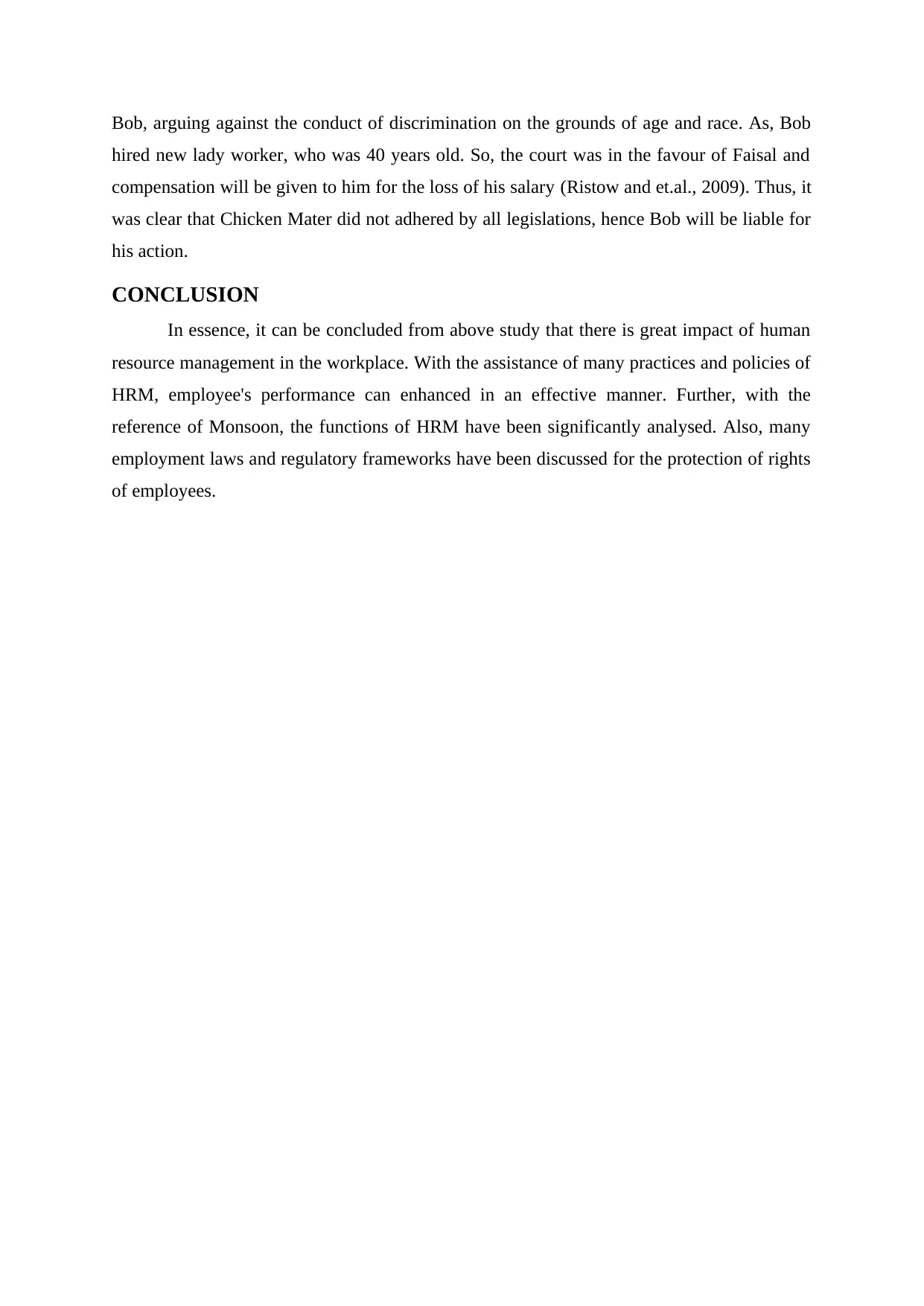
Bob, arguing against the conduct of discrimination on the grounds of age and race. As, Bob
hired new lady worker, who was 40 years old. So, the court was in the favour of Faisal and
compensation will be given to him for the loss of his salary (Ristow and et.al., 2009). Thus, it
was clear that Chicken Mater did not adhered by all legislations, hence Bob will be liable for
his action.
CONCLUSION
In essence, it can be concluded from above study that there is great impact of human
resource management in the workplace. With the assistance of many practices and policies of
HRM, employee's performance can enhanced in an effective manner. Further, with the
reference of Monsoon, the functions of HRM have been significantly analysed. Also, many
employment laws and regulatory frameworks have been discussed for the protection of rights
of employees.
hired new lady worker, who was 40 years old. So, the court was in the favour of Faisal and
compensation will be given to him for the loss of his salary (Ristow and et.al., 2009). Thus, it
was clear that Chicken Mater did not adhered by all legislations, hence Bob will be liable for
his action.
CONCLUSION
In essence, it can be concluded from above study that there is great impact of human
resource management in the workplace. With the assistance of many practices and policies of
HRM, employee's performance can enhanced in an effective manner. Further, with the
reference of Monsoon, the functions of HRM have been significantly analysed. Also, many
employment laws and regulatory frameworks have been discussed for the protection of rights
of employees.
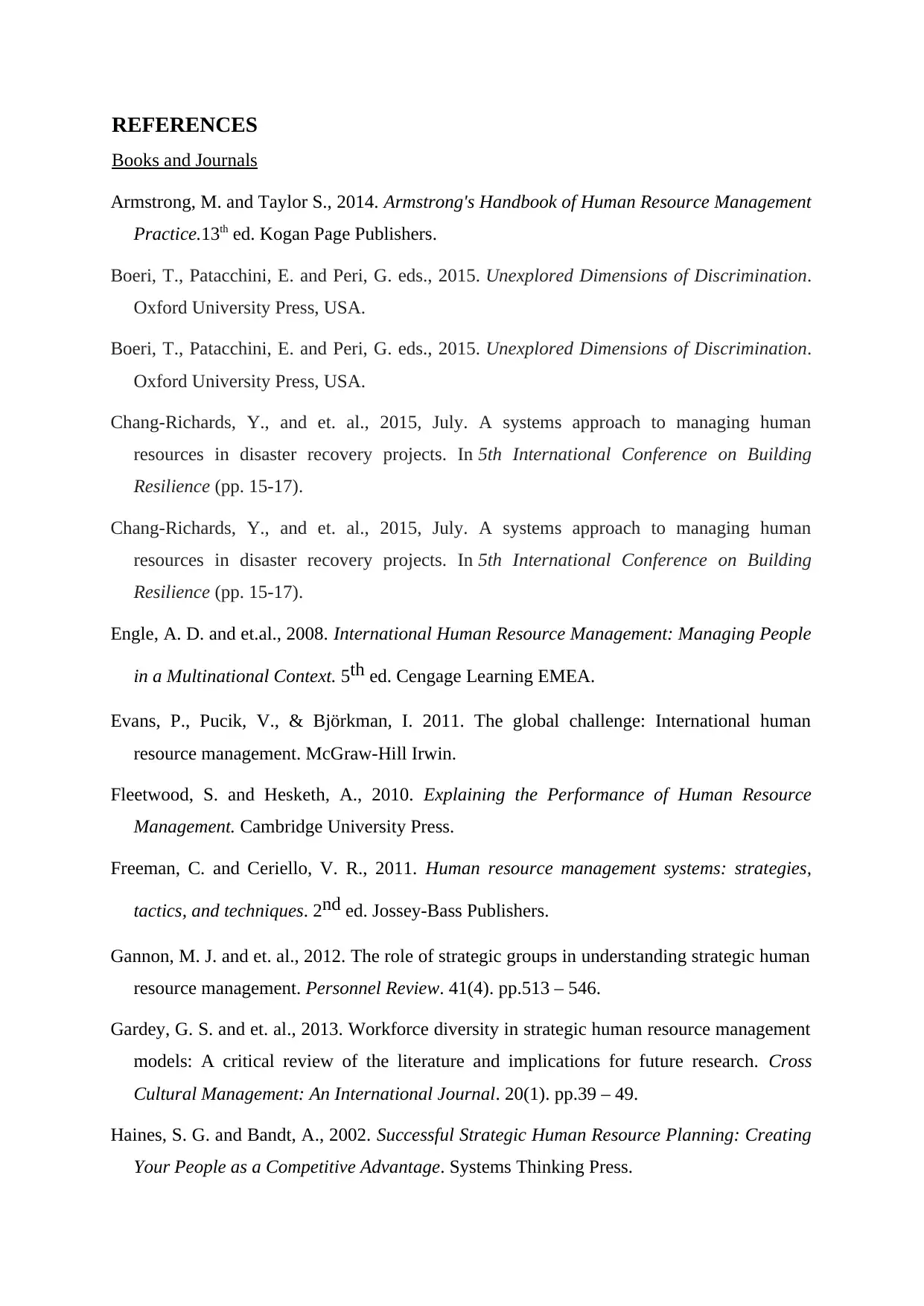
REFERENCES
Books and Journals
Armstrong, M. and Taylor S., 2014. Armstrong's Handbook of Human Resource Management
Practice.13th ed. Kogan Page Publishers.
Boeri, T., Patacchini, E. and Peri, G. eds., 2015. Unexplored Dimensions of Discrimination.
Oxford University Press, USA.
Boeri, T., Patacchini, E. and Peri, G. eds., 2015. Unexplored Dimensions of Discrimination.
Oxford University Press, USA.
Chang-Richards, Y., and et. al., 2015, July. A systems approach to managing human
resources in disaster recovery projects. In 5th International Conference on Building
Resilience (pp. 15-17).
Chang-Richards, Y., and et. al., 2015, July. A systems approach to managing human
resources in disaster recovery projects. In 5th International Conference on Building
Resilience (pp. 15-17).
Engle, A. D. and et.al., 2008. International Human Resource Management: Managing People
in a Multinational Context. 5th ed. Cengage Learning EMEA.
Evans, P., Pucik, V., & Björkman, I. 2011. The global challenge: International human
resource management. McGraw-Hill Irwin.
Fleetwood, S. and Hesketh, A., 2010. Explaining the Performance of Human Resource
Management. Cambridge University Press.
Freeman, C. and Ceriello, V. R., 2011. Human resource management systems: strategies,
tactics, and techniques. 2nd ed. Jossey-Bass Publishers.
Gannon, M. J. and et. al., 2012. The role of strategic groups in understanding strategic human
resource management. Personnel Review. 41(4). pp.513 – 546.
Gardey, G. S. and et. al., 2013. Workforce diversity in strategic human resource management
models: A critical review of the literature and implications for future research. Cross
Cultural Management: An International Journal. 20(1). pp.39 – 49.
Haines, S. G. and Bandt, A., 2002. Successful Strategic Human Resource Planning: Creating
Your People as a Competitive Advantage. Systems Thinking Press.
Books and Journals
Armstrong, M. and Taylor S., 2014. Armstrong's Handbook of Human Resource Management
Practice.13th ed. Kogan Page Publishers.
Boeri, T., Patacchini, E. and Peri, G. eds., 2015. Unexplored Dimensions of Discrimination.
Oxford University Press, USA.
Boeri, T., Patacchini, E. and Peri, G. eds., 2015. Unexplored Dimensions of Discrimination.
Oxford University Press, USA.
Chang-Richards, Y., and et. al., 2015, July. A systems approach to managing human
resources in disaster recovery projects. In 5th International Conference on Building
Resilience (pp. 15-17).
Chang-Richards, Y., and et. al., 2015, July. A systems approach to managing human
resources in disaster recovery projects. In 5th International Conference on Building
Resilience (pp. 15-17).
Engle, A. D. and et.al., 2008. International Human Resource Management: Managing People
in a Multinational Context. 5th ed. Cengage Learning EMEA.
Evans, P., Pucik, V., & Björkman, I. 2011. The global challenge: International human
resource management. McGraw-Hill Irwin.
Fleetwood, S. and Hesketh, A., 2010. Explaining the Performance of Human Resource
Management. Cambridge University Press.
Freeman, C. and Ceriello, V. R., 2011. Human resource management systems: strategies,
tactics, and techniques. 2nd ed. Jossey-Bass Publishers.
Gannon, M. J. and et. al., 2012. The role of strategic groups in understanding strategic human
resource management. Personnel Review. 41(4). pp.513 – 546.
Gardey, G. S. and et. al., 2013. Workforce diversity in strategic human resource management
models: A critical review of the literature and implications for future research. Cross
Cultural Management: An International Journal. 20(1). pp.39 – 49.
Haines, S. G. and Bandt, A., 2002. Successful Strategic Human Resource Planning: Creating
Your People as a Competitive Advantage. Systems Thinking Press.
Paraphrase This Document
Need a fresh take? Get an instant paraphrase of this document with our AI Paraphraser

Hughes, P. and Ferrett, E., 2015. Introduction to Health and Safety at Work: For the
NEBOSH National General Certificate in Occupational Health and Safety. Routledge.
Jackson, J. H. and Mathis, R. L., 2010. Human Resource Management
Available Titles CourseMate Series. 13th ed. Cengage Learning.
Mathis, L. R. and et. al., 2016. Human Resource Management. 15th ed. Cengage Learning.
Pettit, B. and Sykes, B.L., 2015, June. Civil Rights Legislation and Legalized Exclusion:
Mass Incarceration and the Masking of Inequality. In Sociological Forum (Vol. 30, No.
S1, pp. 589-611).
Randhawa, G., 2007. Human Resource Management. Atlantic Publishers & Dist.
Regis, R., 2008. Strategic Human Resource Management & Development. Excel Books India.
Ristow, L. and et.al., 2009. Human Resource Management. 3rd ed. Juta and Company Ltd.
Stockdale, R. and Kühne, S., 2007. The impact of purpose, people and technology on the
virtual project team. Journal of Systems and Information Technology. 9(1). pp.60-77.
Stone, R.J., 2013. Managing human resources. John Wiley and Sons.
Werner, S., and. et. al. 2012. Human Resource Management. South-Western Cengage
Learning.
Online
Brookins, M., 2016. The Reasons for Job Termination. [Online]. Available
through:<http://smallbusiness.chron.com/reasons-job-termination-2900.html>. [Accessed
on 16th July 2016]
Commitment: Maslow’s Hierarchy of Needs and Herzberg Theory of Hygiene Motivation in
business. 2013. [Online]. Available at: <http://chebri.com/commitment-maslows-
hierarchy-of-needs-and-herzberg-theory-of-hygiene-motivation-in-business/>. [Assessed
on 16th July 2016]
Role of HRM. 2013. [Online]. Available at: <http://www.managementstudyhq.com/role-of-
hrm-in-strategic-management.html>. [Assessed on 16th July 2016].
Top Three Recommendations for Implementing an HR Strategy in an Organization. 2014.
[Online]. Available at: <http://smallbusiness.chron.com/top-three-recommendations-
implementing-hr-strategy-organization-2693.html>. [Assessed on 16th July 2016].
NEBOSH National General Certificate in Occupational Health and Safety. Routledge.
Jackson, J. H. and Mathis, R. L., 2010. Human Resource Management
Available Titles CourseMate Series. 13th ed. Cengage Learning.
Mathis, L. R. and et. al., 2016. Human Resource Management. 15th ed. Cengage Learning.
Pettit, B. and Sykes, B.L., 2015, June. Civil Rights Legislation and Legalized Exclusion:
Mass Incarceration and the Masking of Inequality. In Sociological Forum (Vol. 30, No.
S1, pp. 589-611).
Randhawa, G., 2007. Human Resource Management. Atlantic Publishers & Dist.
Regis, R., 2008. Strategic Human Resource Management & Development. Excel Books India.
Ristow, L. and et.al., 2009. Human Resource Management. 3rd ed. Juta and Company Ltd.
Stockdale, R. and Kühne, S., 2007. The impact of purpose, people and technology on the
virtual project team. Journal of Systems and Information Technology. 9(1). pp.60-77.
Stone, R.J., 2013. Managing human resources. John Wiley and Sons.
Werner, S., and. et. al. 2012. Human Resource Management. South-Western Cengage
Learning.
Online
Brookins, M., 2016. The Reasons for Job Termination. [Online]. Available
through:<http://smallbusiness.chron.com/reasons-job-termination-2900.html>. [Accessed
on 16th July 2016]
Commitment: Maslow’s Hierarchy of Needs and Herzberg Theory of Hygiene Motivation in
business. 2013. [Online]. Available at: <http://chebri.com/commitment-maslows-
hierarchy-of-needs-and-herzberg-theory-of-hygiene-motivation-in-business/>. [Assessed
on 16th July 2016]
Role of HRM. 2013. [Online]. Available at: <http://www.managementstudyhq.com/role-of-
hrm-in-strategic-management.html>. [Assessed on 16th July 2016].
Top Three Recommendations for Implementing an HR Strategy in an Organization. 2014.
[Online]. Available at: <http://smallbusiness.chron.com/top-three-recommendations-
implementing-hr-strategy-organization-2693.html>. [Assessed on 16th July 2016].
1 out of 20
Related Documents
Your All-in-One AI-Powered Toolkit for Academic Success.
+13062052269
info@desklib.com
Available 24*7 on WhatsApp / Email
![[object Object]](/_next/static/media/star-bottom.7253800d.svg)
Unlock your academic potential
© 2024 | Zucol Services PVT LTD | All rights reserved.





